














The summer and early fall proved to be no vacation time for the Veterinary School’s $100-million fundraising campaign, Building New Levels ofExcellence.“The outpouring ofsupport for the School is incredible. Alumni,friends,grateful clients,and others continue to come forward with gifts ofall sizes to help reach the campaign’s goals,”says Mark Stuart,assistant dean for development.
Since the last Bellwether,more than $6 million in new gifts and pledges were added to the campaign totals.“In my forty years at the Veterinary School,I have never seen so many people and organizations supporting our teaching, research,and healing missions,”reports
Dean Alan M.Kelly“All campaign priorities have seen an increase in gifts and pledges,”notes Stuart. “We hope to soon finish the fundraising efforts for the Teaching and Research Building and other physical space projects to concentrate our efforts on those areas that have not received the lion’s share of gifts,notably scholarships,faculty professorships,and annual giving,”says Stuart.
The School’s focus remains on completing the Kresge Challenge announced in
June.“We will continue to bring the campaign to cities across the country to engage more individuals in the work ofthe School,” says Dr.Kelly.Campaign event locations include Boston,southern California, southern Florida,Philadelphia,and Philadelphia’s Main Line communities.Dr. Kelly continues,“With $14 million to go, reaching our goal,which was once a dream, is now firmly within our reach.”
Recent major gifts include:
• $1,000,000 from the Estate ofFrances Chaney Glover to establish an endowment for New Bolton Center’s Field Service program.The Field Service completes more than 19,000 visits each year to farms within a 35-mile radius of Kennett Square,Pa.
• $500,000 from two foundations to support the new Radiation Therapy and Imaging Suite at the Ryan Veterinary Hospital.The Richard King Mellon Foundation of Pittsburgh contributed $350,000 and the Bernice Barbour Foundation of Hackensack,N.J.pledged $150,000 to the Hospital’s top clinical need.The Facility will place state-of-art diagnostic tools (MRI and nuclear scintigraphy) and cancer therapy (linear accelerator) under one roof.
• $380,000 from the Allerton Foundation to
In June 2004,the Kresge Foundation offered $1.5million forour new Teaching and Research Building ifthe School raises$13 million for any School need by October 1,2005.
To date,we have already raised $4 million toward the Challenge.This challenge grant comes at a pivotal moment inthe School’s $100-million fundraising campaign, BuildingNewLevelsofExcellence.
With your commitment,Penn will lead the veterinary profession into the twenty-first century in areas crucial tothehealth and well-being ofus all.
support the Teaching and Research Building.This gift brings the Foundation’s support to $1,000,000 and will name a laboratory dedicated to comparative medical genetics in the new Facility.
• $136,000 from the Anton and Judith Musladin Charitable Trust to support the Center for the Interaction ofAnimals and Society (CIAS).This gift will provide funding for the Center’s staff.
• $100,000 from Eric and Caroline Moran Hasbrouck in support ofthe Moran Challenge issued by Elizabeth R.Moran. More than $800,000 was raised by this Challenge to the equine community to support the construction ofthe Teaching and Research Building.
• $100,000 from Katherine A.Houpt,V’63 GR’72,to name a seminar room in the Teaching and Research Building.The space will be named in her honor and in memory ofher late husband, Richard, C’48 V’50.Drs.Houpt,who married while at Penn,joined the faculty at Cornell University College ofVeterinary Medicine in the 1970s.She is the director ofCornell’s Animal Behavior Clinic.
Use the enclosed envelope to make a gift to any School need: scholarships,building projects,Friends ofthe Ryan Hospital or New Bolton Center funds,faculty endowments,etc. Give appreciated assets like stocks or mutual funds—may avoid capital gains altogether and no out-of-pocket expenses. Make a multi-year pledge All pledges count toward the Kresge goal.
Please don’t delay—the goal must be reached by October 1,2005.
We had two substantial events in the School this summer.The first,and most exhilarating,was the start ofconstruction ofour new Teaching and Research Building.Road realignment is largely completed and excavation started in August.As I write in September,we have a huge hole in the ground with pilings driven into the area outlining the perimeter ofthe building. The speed with which the construction firm is progressing is impressive,and I have every confidence that the building will be completed by August 2006.With this in mind,I felt bold enough to tell the incoming freshman class that I expect they will start using the new building in their junior year.
The other substantial event was the reopening ofthe George D.Widener Hospital for Large Animals at New Bolton Center.The multidrug–resistant Salmonella Newport infection was the worst thing to happen to the Hospital in its 40-year history.But,as has been true from the
inception ofNew Bolton Center,we are blessed with a remarkable group offaculty and staff.They rolled up their sleeves and set about cleaning the Hospital,turning the response into one in which we could take pride.In the end,what the staffand faculty accomplished became the most important aspect ofthe whole incident.
For roughly 85 days in the heat ofthe summer, the faculty and staffremoved everything that could be moved from Hospital buildings,even the light fixtures.These were either discarded or cleaned and stored.They then donned protective gear and set about scrubbing and disinfecting the 18 buildings that comprise the Widener Hospital. They scrubbed everything from floor to ceiling, and they scrubbed the driveways around the buildings.The amount ofwork is staggering,and we are profoundly grateful and proud ofall who participated in the process;it was a remarkable job and it saved the Hospital.A special tribute must go to Helen Aceto,V’97, and her biosecurity committee, Drs.Barb Dallap, Brett Dolente,V’96, JanetJohnston,and Kim Olson,and to BruceRappoport and Barry Haines.This group

As a rider and a lover ofhorses,I am especially pleased to be president ofa university that is home to one ofthe world’s truly great schools of veterinary medicine.In my first months here,I have learned that the one ofthe things that distinguishes Penn worldwide is the nature and quality of its School ofVeterinary Medicine.Not only is the School one ofthe world’s leading institutions for teaching,research,and treatment ofanimals,but it is also an active partner in the University’s biomedical/life sciences initiatives.The historic and ongoing collaboration ofclinicians and researchers from the schools ofVeterinary Medicine,Medicine,Arts and Sciences,Nursing,and Dental Medicine offers promise ofnew medical advances for “all creatures great and small.”
I recently visited New Bolton Center to present faculty and staffwith a “Commitment to Excellence”award from the University for their Herculean efforts in reopening the facility after the outbreak of Salmonella earlier this year.New Bolton Center will once again set the standard for care and research—a standard that so many people in Pennsylvania and neighboring states have come to rely on.While I was there,I toured the
facilities and marveled at the services offered by our veterinary faculty and staff.Like any visitor,I was impressed by the diagnostic and treatment capability that rivals any human hospital,as well as what I learned about Penn’s services to the agricultural industry.
I am also struck by the services offered for companion animals at our wonderful Matthew J. Ryan Veterinary Hospital:a world-class emergency service and critical care center that never closes,kidney dialysis,and an Animal Bloodmobile,which is used in the largest voluntary canine blood donor program in the nation,to name just a few.Any veterinary school would be proud to offer just one ofthese services,but Penn offers these services and many more that result in lifesaving treatments for our pets.
One ofthe most exciting developments at the School ofVeterinary Medicine is the construction ofthe new Teaching and Research Building.I look forward to the dedication ofthe new building in 2006,knowing that it will enable the School’s faculty to have the kind offacilities warranted by the level oftheir work.It is amazing to think ofwhat has been accomplished in the current spaces and wonderful to think ofwhat more can be done with up-to-date spaces.How gratifying to know that the Kresge Foundation recognizes the importance ofthe new building and has offered a
directed and facilitated the cleanup with just the right combination ofhumor and resolve.
We celebrated completion ofthe cleanup on August 27 with a lunch and special ceremony attended by University President Amy Gutmann This was the first time our new president had visited New Bolton Center,and she enchanted everyone with her grace,informality,and enthusiasm.Dr.Gutmann was immensely impressed with what the faculty and staffhad overcome and complimented everyone on their achievement. She also presented the Commitment to Excellence Award to New Bolton Center.This is a new University award designed to recognize exceptional service to the Institution.President Gutmann could not have chosen a better venue to introduce this award for it was so richly deserved,but she will have a hard time finding another group that emulates the standard ofexcellence set by the faculty and staffofNew Bolton Center.
Alan M.KellyThe Gilbert S.Kahn Dean ofVeterinaryMedicine

challenge grant to spur contributions toward its completion.As we all know,the building is a key component ofthe campaign, Building New Levels ofExcellence,which will enable the School to lead the way in veterinary education.
We are grateful for the Commonwealth of Pennsylvania’s magnificent support ofthe new building,as well as for the School’s annual appropriation.I want you to know that I am committed to working with the governor and members ofthe General Assembly to maintain the School’s appropriation in the years ahead.(And I am delighted that our governor,Ed Rendell,C’65 HON’00,has been a client ofthe Ryan Veterinary Hospital.)
As I begin to meet more Penn alumni—in Pennsylvania,across the nation,and around the world—I look forward to talking with graduates ofthe School ofVeterinary Medicine.You are among those who have taken the University’s mission ofteaching,research,and service very much to heart.And in the years ahead,I will also meet a wide variety ofpeople who have been clients ofour two veterinary hospitals.I know that I will hear wonderful stories about the extraordinary care provided by our veterinarians.
I feel fortunate,indeed,to have this new association with the School ofVeterinary Medicine and with all ofyou.
The search-and-rescue dogs deployed following the September 11,2001 terrorist attacks have not suffered either immediate or shortterm effects from exposure to the disaster sites, researchers from Penn Veterinary Medicine report.The findings,presented in the September 15 issue ofthe Journal ofthe American Veterinary Medical Association, should help relieve fears about the after-effects ofworking at the 9/11 sites.
For the last three years,researchers at the School tracked the health ofdogs and handlers from the World Trade Center,the Pentagon, and the Fresh Kills Landfill site on Staten Island,where debris from the World Trade Center was further searched.
“Overall,the lack ofclear adverse medical or behavioral effects among the 9/11 dogs is heartening,both for the animals and the human rescue workers,”said lead researcher Dr.Cynthia M.Otto,associate professor ofcritical care.
“Since dogs age more rapidly than humans,they can serve as sentinels for human disease.We are encouraged that we do not see significant increases in cancer and respiratory diseases.”
Researchers compared the dogs to a control group ofsearch-and-rescue dogs that were trained similarly but not deployed.
Although there is no single registry ofall dogs deployed to search the 9/11 sites,Penn researchers identified 212 deployed handlers,
The nation’s largest farm show is held in Pennsylvania.It will be held January 8 to 15, 2005 in the State Farm Show Complex in Harrisburg.The School will have a booth in the exhibition area and also will offer programs in the Family Living Area in the complex.
The dates and topics are:
January 11,3:00 p.m.Public Health Issues Related to Domestic Pets,Dr.Gary Smith
January 12,6:00 p.m.Biosecurity at the Farm Level,Dr.Robert Munson
January 13,1:00 p.m.Biting the Hand That Feeds:Understanding Canine Aggression to Owners,Dr.Ilana Reisner
January 14,4:00 p.m.The Salmonella Situation,Cleanup,and Biosecurity at New Bolton Center,Dr.Helen Aceto
January 15,12:00 p.m. Salmonella and Food Safety,Dr.Eric Gingerich
and 97 consented to participate.
Despite rumors ofnumerous deaths of9/11 search-and-rescue dogs,only one was confirmed to have died during the search period.In addition,the study was able to demonstrate that the injuries and ill effects ofthe search itselfwere minor.After the first year of
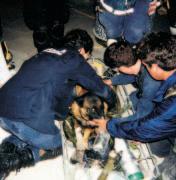
The examinations showed no apparent lung abnormalities.While it usually takes humans at least 20 years to develop mesothelioma after asbestos exposure,the shorter lifespan ofdogs often means a relatively shorter latency period for developing cancer.
To assess the psychological well-being ofthe dogs,their handlers completed questionnaires that focused on behavioral disorders,such as aggression or fearfulness,which may have arisen since 9/11.Here also,the deployed dogs seemed similar to those ofthe control group. An ongoing study led by Melissa Hunt ofthe Department ofPsychology is looking at the long-term psychological consequences for the human handlers.
“Since this is the first major study on searchand-rescue dogs and their handlers,we hope this data can be used to establish a baseline for future studies,”Otto said.“Not only will it help ensure the health and safety ofsearch-andrescue dogs,but it will also help anticipate human disease as well.”
surveillance,ofthe 97 deployed dogs enrolled in the study,only one died.During the past three years,15 deployed dogs have died,of which eight had cancer.Currently,neither the death rate nor the cancer rate is different from that ofthe control group.
“Given the mature age ofthese dogs and their expected lifespan,the few deaths that did occur were not statistically significant,”Otto said.“We can say that these findings preclude illness later in life,but it is clear that we don’t see any trends in the current physical or behavioral well-being ofthese dogs that would be cause for alarm.”
Initially,blood tests showed that the deployed dogs exhibited higher bilirubin concentration and alkaline phosphatase activity, which indicate that their livers were actively filtering toxins from their bloodstream.The serum globulins were also higher in the first year in deployed dogs,suggesting activation of the immune system.As the study progressed, however,these numbers came down to close to those ofthe dogs in the control group.“Early on,it was clear that these dogs were dealing with some stress from toxins.Although we don’t currently have evidence ofadverse effects,continued surveillance is still warranted,”Otto said.
Since there was a concern about airborne pollutants,such as asbestos,Otto and her colleagues also examined x-rays taken ofthe dogs.
Support for the study came from the AKC Canine Health Foundation,the American Kennel Club,Ralston Purina Co.,the Veterinary Pet Insurance Co.,and the Geraldine R.Dodge Foundation.The study also includes researchers at Michigan State University and the Centers for Disease Control in Atlanta.
The AKCCanine Health Foundation and AKCCompanion Animal Recovery have approved a new two-year grant,effective January 1,2005,that will allow Dr.Otto to continue to study the health ofdogs deployed on 9/11.
The School will host an all-day Breeders Symposium on campus sponsored by the American Kennel Club and the AKC Canine Health Foundation on January 29, 2005.Topics covered include the “ABC’s of Breeding,”presented in the keynote address by Claudia Orlandi,Ph.D.Penn faculty will speak about reproduction,genetics ofcancer,inherited cardiac diseases,feeding dogs for health and longevity,and vaccination protocols.
Reservations and registrations for the event will be handled by the Canine Health Foundation.The complete program,cost, and other information will be on its website shortly at <www.akcchf.org>.
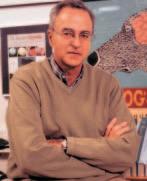 By Susan I.Finkelstein
By Susan I.Finkelstein
A couple ofunpacked cardboard boxes placed neatly atop a filing cabinet are the only indication that Gustavo Aguirre,V’68,GR’75, professor ofmedical genetics and ophthalmology,returned to the Ryan Hospital just this July, after a 12-year stint at Cornell.Other than the boxes,the second-floor office appears never to have been inhabited by anyone else:framed covers ofjournals featuring Dr.Aguirre’s work adorn the walls,as do as artistic renderings of eyes in various abstract states,a needlepoint wall-hanging ofdog faces,and other assorted pieces.One ofthe country’s foremost veterinary ophthalmological and gene-therapy researchers,Dr.Aguirre—earning his V.M.D. and Ph.D.at Penn,and serving on the faculty here for over 20 years—has truly come home. Dr.Aguirre’s research focuses on inherited diseases ofthe eye,especially degeneration of the retina in dogs,humans,and other mammals.In 2001,he,his colleagues at Cornell’s James A.Baker Institute for Animal Health,and researchers at Penn were the first to restore vision in blind dogs using gene therapy:
The Class of2008 arrived on campus for orientation at the end ofAugust.Eightyseven women and 21 men,ranging in age from 21 to 48 years,with a mean GPA of 3.54,are already hard at work,coping with the heavy courseload.The majority ofthe students,64 percent,are from Pennsylvania, the balance are from New Jersey (8),Massachusetts (7),New York (5),Connecticut, Illinois and Virginia (3 each),international (2,Bermuda and Japan),and one each from Colorado,District ofColumbia,Kentucky, Maine,Maryland,and Oregon.The School received 1,217 applications and made offers to 154 applicants.
The majority ofthe students’undergraduate degrees is a BS (64);a BA was earned by 43 and BFA by one.Five students have an MS,two an MA,and one an MLAS. Eight students received their undergraduate degrees from Penn and Cornell.In all,62 undergraduate schools are represented in this class with 35.2 percent ofthe students having attended top-tier (most competitive) schools,24.1 percent second-tier (highly competitive) schools,and 21.3 percent third-tier (very competitive) schools.
“Lancelot,”a four-year-old briard mix blind since birth,was the first creature ever to recover sight thanks to this revolutionary work,which also holds promise for curing a similar disease in children,Leber congenital amaurosis.In gratitude,

Lancelot has appeared before Congress with the Aguirre team for their testimony on the importance ofincreased funding for eye research to advance gene therapy—certainly an unusual lobbyist!
In the experiments involving Lancelot and three ofhis littermates,Dr. Aguirre and his colleagues injected a virus carrying a healthy copy ofthe defective gene into a part ofthe retina containing lightsensing cells.The virus “infected”those cells, releasing the normal gene material.Within three to four weeks,cells with the healthy copy began to produce vitamin A that,together with opsin, formed the visual pigment rhodopsin,eventually allowed the dogs to see for the first time in their lives.Work,however,remains to be done in developing and testing gene therapy applications in dogs with other congenital disorders— and,more importantly,in people.“Regardless ofhow successful the treatment has been for dogs,it is essential that more studies are carried out to establish the long-term safety and efficacy ofgene therapy for human patients,”Dr. Aguirre notes.
Currently,Dr.Aguirre is involved in research regarding a hereditary,blinding disorder ofthe retina called progressive retinal atrophy,or PRA as it is commonly known.This disease was first recognized in Gordon setters in Europe in the early twentieth century,but PRA has since been identified in many breeds.In human families, the diseases equivalent to PRA in dogs are termed retinitis pigmentosa.
Siberian huskies and Samoyeds have a unique type ofPRA called X-linked PRA,since it is transmitted through the X chromosome of
the mother.X-linked PRA is the “most common severe,inherited disease ofthe retina,”says Dr.Aguirre,who has identified the genetic defect that causes the disease.The test that detects the mutation will allow breeders of huskies and Samoyeds—and eventually other breeds as well—to prevent X-linked PRA in their lines by recognizing the carrier females. Significantly,since dogs and people share such similar genetic makeups,the research has the potential to identify the causes ofsome cases of X-linked blindness in humans.
Given the growing attention garnered by gene therapy and the entirely new methods of treating disease it is generating,the return ofGus Aguirre to Penn has been quite a coup for the School. And the benefits are mutual:
“It was great coming back to Philadelphia;my family still lives in the area,”says Dr. Aguirre—in fact,one ofhis sons,Dr.Geoffrey Aguirre, GR’98,M’00,is an assistant professor in the Center for Cognitive Neuroscience at Penn Medicine.The two Aguirres are collaborating on a project studying the brains ofdogs before and after gene therapy restored their vision.
Now,ifonly those last parts for Dr.Aguirre’s fluorescent microscope would arrive….
Effective July 1,a number offaculty members were promoted:
Dr.Charles H.Vite to assistant professor ofneurology; Dr.Anna S.Kashina to assistant professor ofbiochemistry; Dr.Amy Kapatkin to associate professor ofsurgery; Dr.Karen L.Rosenthal to assistant professor ofspecial species medicine and surgery; Dr.Gabriela S.Seiler to assistant professor ofradiology; Chick Weisse,V’98,to assistant professor of surgery; Dr.Wilfried Mai to assistant professor ofradiology; Dr.Andras Komaromy to assistant professor ofophthalmology; Drs. Danian Gu, Petra Werner,and Barbara Zangerl to research assistant professors of medical genetics;and Dr.Robert Poppenga to professor oftoxicology.
Cancer.The Big “C.”The very name invariably conjures fear.According to recent statistics, one ofevery three Americans will face a diagnosis ofcancer.But what many people don’t know is that pets get cancer,too—and in evergreater numbers.Like people,more companion animals are living longer due to better quality oflife,preventive medical care,and vaccinations—and longer life translates into an increased risk ofdeveloping cancer.Over 10 percent ofdogs and slightly fewer cats develop the disease each year,roughly the same rate as humans.Halfofveterinary patients over 10 years ofage will get cancer,and about onequarter will die from it.
Enter the Oncology Service at the Ryan Hospital,dedicated to providing compassionate,efficient,state-of-the-art care to dogs and cats with cancer.Board-certified veterinary and radiation oncologists,residents in training for
Service:Archie the cat,her wise and devoted companion of10 years,was diagnosed with lymphoma after two months ofintermittent severe vomiting and diarrhea.After much discussion with Oncology clinicians,Pat decided to pursue an aggressive course ofchemotherapy.Archie and Pat were both put in the “stubborn fighter”category,and Beth Overley, V’00,lecturer in oncology,and Jen Baez,V’92, assistant professor ofoncology,felt that chemotherapy could conservatively extend Archie’s life and increase his quality oflife for six to nine months,possibly a year.Nineteen months later—a period that included a remission in which he did not require intravenous chemotherapy—Archie’s previously low-grade heart murmur seemed to worsen,and ultimately heart problems caused his death.He was in a treatment hiatus when he died,and technically still in a form ofcancer remission.
“The entire Oncology staff,including all the interns who helped us throughout Archie’s 19month chemotherapy saga,were wonderful,” recalls Pat.“In addition to excellent veterinary clinical training and practice,they had profound ‘people sense’and were compassionate and responsive....I have to say that the whole department had an infectious,positive attitude. Archie and I both took on their positive approach,and neither ofus second-guessed or regretted our association with Oncology and chemo,even when the going got very tough.”
need more aggressive treatment than the standard chemotherapy,surgery,or traditional radiation allows.Penn’s radiation equipment,now almost 40 years old,is no longer the most effective or humane cancer-treating technology available.As a result,each year the Hospital is forced to turn away or refer hundreds ofcancer patients elsewhere due to lack ofappropriate
certification,and oncology nurses all are part of the Ryan team,which handled an estimated 2,800 patient visits last year.Standard cancer treatments similar to those used in people (chemotherapy,radiation therapy,and surgery) may prolong survival and provide an excellent quality oflife in many dogs and cats with cancer.Unlike with people,though,the goal of treating cancer in companion animals is not necessarily eradicating the tumors,but improving the animal’s overall comfort level.
Pat Thatcher,associate director ofPenn’s Office ofLearning Resources,recently had a very personal experience with the Oncology
In February 2003,together with four others, Pat founded the Pets with Cancer Lifeline,a support system for people whose pets are being treated at the Ryan Hospital’s Oncology Service. On its website,<www.dogdoggiedog.com/ PetswithCancer.htm>,the grassroots group describes itselfas a “network to provide information and support to the families ofthe newest Oncology patients who have practical questions about pets living with cancer,or simply want to talk with someone whose pet has received a similar diagnosis.”Along with stories and photos ofpets who fought cancer—and beat or succumbed to it—are names and email addresses for those wishing to contact one of the cofounders.“We can tell you that our pets have done well in treatment,with excellent quality oflife and minimal side effects.We know that Ryan’s Oncology Service provides exceptional treatment....We know they truly care about each and every patient.”
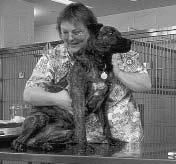
As Archie’s case suggests,some animals may
equipment.To ameliorate the situation,the School has launched a fundraising campaign to convert its 8,000-square-foot parking garage into a comprehensive Radiation Therapy and Imaging Facility that will house a linear accelerator (high-energy radiation),an MRI suite,and nuclear scintigraphy (bone scan) equipment— making the School the major academic referral center in the eastern United States for diagnostic imaging and treatment ofcompanion animals.
The Research
Healing,though,is only one part ofOncology at Penn Veterinary Medicine;information gleaned from clinical research with veterinary patients provides valuable knowledge that can improve the understanding and treatment of both human and animal cancers.Because many ofthese trials are funded by grants,pet owners often are not charged or pay just a part ofthe cost ofthe animal’s participation.
“Clinical trials involving companion animals are often the stepping stone to clinical trials in humans,”notes Dr.Baez.The Oncology Service currently is involved in many clinical trials,a partial list ofwhich appears below.
Feline cancer cachexia: The goal ofthis study is to determine the incidence ofcachexia (weight loss,wasting ofmuscle,and general debility) among cats presented to the Oncology Service at the Ryan Hospital and to compare
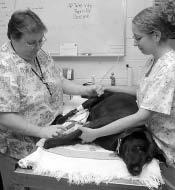
the incidence ofcachexia in the cats with and without tumors that are being treated here.
Canine hemangiosarcoma: Clinicians are examining the efficacy and toxicity ofthe chemotherapy drug Doxil following surgery on dogs with hemangiosarcoma,an aggressive malignancy ofblood vessels and the lining of blood-filled spaces,most commonly the spleen.
Feline mammary tumor: This study evaluates the role that reproductive/hormonal status plays in the incidence ofbreast cancer in female cats.In human and dog breast cancers,studies show that reproductive/hormonal status is important in the prognosis,prevention,and treatment ofdisease.In dogs,a study similar showed an increased risk ofbreast cancer correlated with the age at which a dog was spayed.A more recent study also showed that dogs spayed around the time ofdiagnosis ofmammary cancer enjoyed potentially improved survival rates as well.
Canine melanoma: This study aims to determine ifthe addition ofchemotherapy to the treatment ofdogs with early-stage oral melanoma (skin cancer) will improve survival rates.Previous studies have evaluated treatments ofthe primary tumor but have not addressed treatment and prevention ofmicroscopic secondary tumors.Even with excellent local treatment and no evidence ofthe spread ofcancer at diagnosis,most diagnosed dogs (70–85%) still die from melanoma.(Preliminary results ofthis study indicated a positive difference in overall survival.)
Magnetic resonance imaging ofcanine splenic and liver lesions: The effectiveness of MRI ofthe human spleen has been little studied due to the relative rarity ofhuman splenic lesions.In dogs,however,splenic lesions are relatively common.Unfortunately,ultrasound,the cross-sectional imaging modality most readily available to veterinarians,cannot reliably differentiate benign from malignant splenic and liver lesions.In this prospective study,Oncology staff will perform MRI examinations on dogs with splenic and liver lesions that have been scheduled for surgery or biopsies.They seek to determine the MRI characteristics ofthese lesions and to correlate MRI findings with pathologic examination ofthe spleen,to better define the effectiveness ofMRI in determining the nature ofsplenic and/or liver lesions in both dogs and people.This study is funded via grants from the Hospital ofthe University ofPennsylvania
(Radiology) and Ryan Clinical Research.
Canine lymphoma study: In human medicine,it is well known that lymphoma is not a solitary disease but a variety ofdisease,each involving cancer oflymph cells.Treatment and outcome are different according to sub-type.It is also known that treatment oflymphoma with chemotherapy can effectively wipe out parts ofthe immune system for prolonged periods,which can affect a patient’s ability to fight offinfections and other cancers.This study will better characterize the sub-types ofmalignant lymph cells by flow cytometry and correlate the results with standard classification schemes and treatment outcome to establish new prognostic markers in this disease.Flow cytometry is also being used to characterize the circulating normal lymph cells to elucidate the role ofthe patients’immune system in maintaining remission.Thus,results will help us further understand and eventually better treat this important and relatively common canine cancer.
Evaluation ofthe cancer-prevention effects ofnon-steroidal drug use in dogs: Results from human studies show that chronic non-steroidal anti-inflammatory drugs (NSAID) may prevent or slow development ofvarious types ofcancer. This preliminary study examines the chemopreventive effect ofNSAID use in dogs,and early results indicate that NSAID use may be associated with decreased cancer risk in dogs.
Feline large granular lymphoma study: Large granular lymphoma (LGL) is a rare variant offeline lymphoma.This study aims to characterize clinical findings for cats diagnosed with LGL.Results to date show that feline LGL does not respond well to traditional surgical or medical treatment,with survival times ofonly 45 days.Future studies include evaluation of additional cases,determination ofmore effective treatments,and molecular characterization offeline LGL cell types.
Treatment for canine malignant histiocytosis: Canine malignant histocytosis/disseminate histocytic sarcoma is a rare canine cancer with a grave prognosis.No effect treatment is known. A preliminary study determined that approximately 50 percent ofdiagnosed dogs respond to the chemotherapeutic agent lomustine.Current studies are under way to evaluate molecular mechanisms ofdrug resistance in tumors that do not respond to treatment.
These projects vary in scope and size and affect both animals and humans.The ultimate
goal that underlies each study is finding out more about cancer—and ultimately about seeking its cure.In the meantime,while providing care to thousands ofpets with cancer,the Ryan Oncology team continues to add to the body ofknowledge that enhances our ability to control this disease,evidence once again that physicians and veterinarians are truly practicing “One Medicine”at Penn.
Editor’s note: For more information,visit Oncolink,the Internet’s first cancer resource, sponsored by Penn’s Abramson Cancer Center, at <www.oncolink.upenn.edu>.
The Student Chapter ofthe American Veterinary Medical Association (SCAVMA) will be holding its annual auction on Friday, December 3,2004,in the E.R.Marookian, V.M.D.Auditorium at the Matthew J.Ryan Veterinary Hospital ofthe University of Pennsylvania.
Come,bid,and go home with new and impressive items,ranging from home decorations to exciting vacations.The event begins with a silent auction at 3:00 p.m.,followed by a live auction at 5:00 p.m. SCAVMA will also be selling Penn Veterinary Medicine merchandise while other student clubs will provide food and drinks.
Everyone is invited to support the auction! The SCAVMA auction is a popular event for the entire School community and benefits current students.Proceeds from the silent auction defray the cost ofstudent travel to the annual National Student AVMA Symposium.In addition,the live auction proceeds help fund SCAVMA events and the SCAVMA Scholarship Program,which awards scholarships totaling $5,000 to students based on their service to the School, academic standing,and financial need.
The mission ofSCAVMA is to increase the quality ofveterinary student life through educational,social,and cultural extracurricular activities.Please help support this important mission.For more information on the auction or to donate auction items,contact Shannon Omlor,V’07,Auction Co-Chairperson,via email at somlor@vet.upenn.edu.




The Veterinary School’s teaching awards were presented during the Veterinary Medical Student Government Teaching Award Ceremony and Reception on April 27 at Houston Hall.
Dean Alan M.Kelly presented the Dean’s Award for Leadership in the Basic Sciences to Thomas J.Van Winkle,V’75,professor ofpathology;and the Dean’s Award for Leadership in Clinical Science to Dr.Kathryn Michel,assistant professor ofmedicine.
The two Dean’s Awards honor one faculty member from the clinical departments and one from the basic science departments who have made outstanding contributions to teaching their disciplines.
Dr.Robert Gilley was presented the Carl J. Norden Distinguished Teacher Award.The Norden Award was






established in 1963 “to recognize outstanding teachers who,through their ability,dedication, character,and leadership, contribute significantly to the advancement ofthe profession.”


The four classes honored the faculty members they considered to be outstanding teachers.The Class of2004 presented awards to Dr.Dean Richardson,professor of surgery,and Dr.Robert Gilley,assistant professor ofsurgery.The Class of 2005 honored Patricia Sertich,V’83,associate professor ofreproduction. Dr.Amy Kapatkin, associate professor of surgery,received the Class of2006 Award.The Class of2007 presented its award to Mark Donaldson,V’93,assistant professor in equine field service.
The Senior Class Residents Awards were presented to Dr.Philipp Mayhew (Ryan) and Dr. Kathryn Worman

(Widener).Senior Class Interns Awards were presented to Nate Harvey,V’03 (Widener) and Dr. Todd Bishop (Ryan).The Class honored veterinary technicians Claire Richardson (Ryan) and Emily Zug (Widener). Other awards presented were:the Interns Award to Dr.Stephen Mehler (Ryan);the Resident’s Award to Dr. Karen Rosenthal (Ryan): the Jules and Lucy Silver Award to Dr.Daniel Hume (Ryan);the Boucher Award to Amy Bentz,V’97 (Widener); the Harcum College Technician Award to Eileen Rule (Widener) and Donna Sisak (Ryan); the Gretchen Swartz Award to Jennifer Wrigley (Widener) and Emily Zug (Widener); Senior Student Patient Awards to Simon Alexander,V’04, Elizabeth Appleman,V’04,and Oliver Morgan,V’04; the Veterinary Medical Student Government Commendation Awards to Sarah Whelan, Bobbie Jo Fettner,and Christen Wink.
A number ofclinicians attained diplomate status in the American College of Internal Veterinary Medicine: Jennifer Baez, V’92,assistant professor in oncology,and Beth Overley,V’00,lecturer in oncology,in the specialty ofoncology;and Dr.Reid Groman,staffveterinarian,in internal medicine.
Dr.Hannah Galatino-Homer,postdoctoral fellow,is now a diplomate ofthe American College ofTheriogenologists; Dr. Laurie Sorrell-Raschi,lecturer in critical care–anesthesia,is now a diplomate ofthe American College ofVeterinary Anesthesiologists.






Trade in wildlife pets,helped by the Internet, has become a multi-million-dollar illegal business.It is reported that 352,000 species are traded. No federal laws prohibit ownership ofexotic pets, although regulations are in place for animal wholesalers and retailers,transportation companies,and animal exhibitors.Thirteen states— Alaska,California,Colorado,Connecticut,Georgia,Hawaii,Illinois,Massachusetts,Minnesota, New Jersey,Vermont,Virginia,and Wyoming— prohibit keeping dangerous wildlife as pets.The definition of“dangerous”varies from state to state.In some states,it includes nonhuman primates,large carnivores,and venomous reptiles.In others,it may mean only large felids.A federal act restricts the importation and transportation of wildlife deemed injurious to humans,agriculture, horticulture,or forestry.Some ofthe “injurious” species are flying fox,meerkat,mongoose,raccoon dog,or brown tree snake.There also are restrictions on primates,turtles under four inches long,bats,civets,some Asian birds,and tenrecs (which can transmit foot-and-mouth disease).
An important consideration is the possibility ofdisease that might be transmitted to humans, other pets,or agricultural animals by a bite or contact.People owning nontraditional pets are often unable to meet the animal’s nutritional, housing,social,and behavioral need.Many captive wild animal pets are abandoned when they mature and become harder to manage.Accidentally released pets may thrive and cause damage to native wildlife.
The American Veterinary Medical Association (AVMA) has adopted a position statement on tail docking ofcattle.“The AVMA opposes routine tail docking ofcattle.Current scientific literature indicates that routine tail docking provides no benefit to the animal and that tail docking can lead to distress during fly seasons.When medically necessary,amputation oftails must be done by licensed veterinarians.”

The AVMA also supports the concept ofearly (prepubertal,eight to 10 weeks ofage) spay/ neuter in dogs and cats in an effort to reduce the number ofunwanted animals ofthese species. Veterinarians should use their best medical judgment on deciding at what age spay/neuter should be performed on individual animals.
AVMA is opposed to the removal or reduc-
tion ofcanine teeth in non-human primates or exotic and wild carnivores except when required for medical treatment or approved scientific research.To minimize bite wounds,recommended alternatives to dental surgery include behavioral modification,environmental enrichment, and changes in group composition.
A study to determine whether winning best in show at the annual Westminster Kennel Club Dog Show is associated with a subsequent increase in popularity was published recently in the Journal ofthe American Veterinary Medical Association.The study used numbers ofpurebred puppies registered with the American Kennel Club (AKC).The results did not support the view that there is a surge in popularity ofwinning breeds.It is suggested however,that in the future, high-profile televised dog shows may have a significant influence on breed popularity.
In a few instances,booms in registrations of certain breeds have been linked to media exposure such as occurred following the 1996 movie 101 Dalmatians,when registrations ofdalmations increased from 6,800 to 42,816.This popularity was short-lived—registrations decreased to 1,112 in 2003.
Only purebred dogs registered with the AKC may compete at their championship shows.At the present time,there are 153 AKC-registered breeds, with more being added as they become established in this country.
Many mixed-breed dogs may be wonderful pets.One that is increasingly popular is the labradoodle.It was developed in Australia and is said to combine the non-shedding,allergy-
friendly coat and high IQ ofthe poodle with the gentle,eager-to-please temperament ofthe Labrador retriever.These dogs have become a very expensive fad and one can only hope that people will not tire ofthe dogs and give them up to a shelter.There is no established standard.It is conceivable that these dogs may become an officially recognized breed,but this will take many years.
The advantage ofhaving a purebred dog is that it has a history and breed standard.One can do research before purchasing to determine which is the right breed.A breed may be energetic, sedate,extroverted,or prefer the fellowship ofone or two familiar faces.Unfortunately,many people purchase a puppy on impulse,without considering eventual size,appearance,and personality.
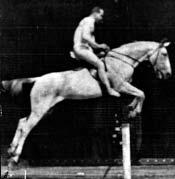
Eadweard Muybridge,born Edward James Muggeridge in 1830,in England,has been called the father ofmotion pictures.In 1878, using 12 tripwired cameras,he produced pictures showing that all four feet ofa galloping horse may be offthe ground at once.Leland Stanford,the railroad tycoon,owned the horse and track in Palo Alto,California.It is said that this was done to settle a $25,000 wager Stanford had made.
In 1879 Muybridge invented the “zoopraxiscope,”which projected sequential stop-action photographs onto a screen,creating an illusion ofmovement.He toured with the device in England and France,returning to the United States in 1883.He pursued his motion studies at the University ofPennsylvania.His studio was set up at the Veterinary School at 36th and Pine Streets. The courtyard was the venue where humans and some ofthe animals were photographed.A tall board fence was erected for privacy.His subjects were humans,nude or draped.They were depicted in many activities—walking,running,horseback riding,etc.Athletes were depicted playing baseball and cricket and more.Artisans were shown shoeing a horse,farming,and laying bricks.Birds and animals were photographed at the Philadelphia Zoo.It was discovered that a pigeon flaps its wings 600 times in a minute.
These photographs were published in an 1887 work, Animal Locomotion,100,000 photographs in 11 volumes.His book, The Human Figure in Motion,was published in 1901.The photographs opened the eyes ofartists and scientists to the mechanics ofmovement.
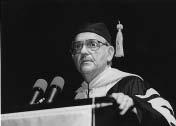
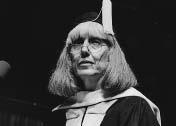

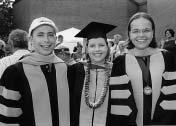
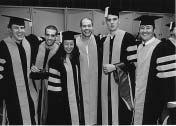
Students and their families assembled at the Zellerbach Theatre ofthe Annenberg Center on May 17 for the 119th Commencement Exercises ofthe School.
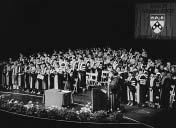
With the Class of2004,Penn has graduated 6,053 veterinarians,1,987 women and 4,066 men.The Class of2004 numbered 109 and is composed of78 women and 31 men.


Dean Alan M.Kelly welcomed everyone and introduced the commencement speaker, Dr.Marguerite Pappaioanou,associate director for science and policy,Office ofGlobal Health,Centers for Disease Control and Prevention.
In the presentation ofdiplomas and the hooding,Dr.Kelly was assisted by Dr.Robert S. Gilley,Jr.,Carl J.Norden Distinguished Teacher Awardee; Dr.Kathryn E.Michel, Dean’s Awardee for Leadership in Clinical Science Education;and Associate Dean Jeffrey A.Wortman,V’69.
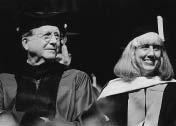

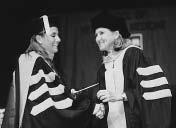
Class President Karen O’Connor presented comments and received the Class Flag from James V.Stewart,V’68,president ofthe Veterinary Medical Alumni Society.Dr.Kelly then awarded the prizes to graduates.In this he was assisted by Dr.Corinne Sweeney,Lindback Distinguished Teacher Aawardee.The Veterinarian’s Oath was administered by Michael R.Moyer,V’90,president ofthe Pennsylvania Veterinary Medical Association.
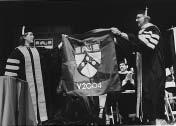
Simon John Alexander
Donna Yaeko Almondia
Ellen Rachael Angstadt
Michael Joseph Anthony
Elizabeth Helene Appleman**
Aylin Atilla
Kara Ann Ballek
Mandy Marie Becker***
Allison Paige Billings
Stacia Anne Gibbons Boswell
Raúl Casas-Dolz
Adriane Cavanna***
Jennifer Helene Chachkes
Dora Louise Connelly**
Gabrielle Hansen Consolino
William Thomas Noble Culp
Dominic Mathew Dallago
Angela Johanna Davies
Daphne Alyson Downs
Patrick Thomas Dubbs
Meagan Colleen Duffy
Lori Ann Duggan
Christopher Peter Dykhouse
Jessica Ivanne Dymun
Joshua Seth Eaton**
Holly Marie Edwards
Paul Gary Egrie
Daniel Eisenberg
Leonard Pearson Prize
Aylin Atilla
J.B.Lippincott Prize
Mandy Marie Becker
1930 Class Prize in Surgery
Jennifer Anne Kaae
Auxiliary to the American Veterinary Medical Association Prize
Rachel Elizabeth Pearson
Faculty/Student Chapter, AVMAPrize
Joshua Seth Eaton
American Animal Hospital Association Award
Megan Julia Manfredi
American Association ofFeline Practitioners Award
Alene Beth Schneiderman
Lauren Jane Entes
Katherine Stanford Gardner
Alfredo J.Geigel-Ortiz
Scott Dennis Gellman
Timothy Alexander Georoff*
Angelee Alexander Gerovasiliou
Mathieu Maniet Glassman
Stephen Mitchell Godin
Marie Haddock
Siobhan Marissa Haney
Kristen Burger Hart
Cailin Rachel Heinze***
Kathy Joe Heym
Craig Liam Hopkins
Carrie Ann Horton**
Laura Helen Javsicas**
Jennifer Anne Kaae***
Jill Ann Kalman
David Brian Kersten
Jeremy Harrison Knoebel
Michael William Koch
Kimberly Jean Kovath
Kelly Jennifer Krell
Ann Marisa Kroken***
Robert Matthew Kuhar
Mary Louisa Landis
Bjørn Armitage Lee*
Christopher Telemachus Lesbines
American College ofVeterinary Radiology Award
Oliver David Eversfield Morgan
American College ofVeterinary Surgeons Prizes
Small Animal Surgery Prize
William Thomas Noble Culp
Large Animal Surgery Prize
Raúl Casas-Dolz
Everingham Prize for Cardiology
Dora Louise Connelly
Field Service Prize
Ann Marisa Kroken
The Peter Francis AnatomyAward
Mandy Marie Becker
Hill’s Award
Elizabeth Helene Appleman
Jinny Ann Lin
Lisa Lipitz**
Jessica Hannah Luftman
Courtney Sachiko Maeda
Megan Julia Manfredi***
Robert Louis Mankowski
Elizabeth Marie Marshall
Eric Jonathan Matkowski
Melissa Miele
Oliver David Eversfield Morgan*
Freya Lauren Moskowitz
Linda Ann Nelson
Cynthia Katherine Nigrini
James Norwell Nutt IV
Karen Ann O’Connor
Sara Beth Organist
Vivian Miyako Orita
Nancy Miyoung Park
Jocelyn Patterson
Amy Marie Pavlock
Rachel Elizabeth Pearson*
Regina Erin Pellegrin *
Amy Elizabeth Poulin
Anne Elizabeth De Boeck Prickett
Laurie Gail Prober
Christa Maureen Regan***
Rosemary Lee Riley
Lynne Ann Robbins
James Hazlitt Jones Prize in Biochemistry
Lisa Lipitz
Large Animal Medicine Prize
Ellen Rachael Angstadt
Large Animal Surgery Prize
Steven Thomas Zedler
Merck Awards
Small Animal Award
Adriane Cavanna
Large Animal Award
Laura Helen Javsicas
1956 Class Medal for Achievement in Pathology
Carrie Ann Horton
George M.Palmer Prize
Marie Haddock
Kelli Nicole Russell**
Sara Jane Ryan
Michael Baldwin Schindler
Alene Beth Schneiderman*
Jessica Kirby Schoell
Wendy Suzanne Schotland
Rebecca Ingles Schrader
Jennifer Diane Seybold
James Thorpe Shissler
Michelle Kim Singer
Lori Michelle Siracuse-Parker
Abigail Gray Smith*
Courtney Petit Snelham
Christine Spodnick
Sarah K.Sprague
Bridget Margaret Stewart
Lynne Alexandra Stine
Tara Anne Strawderman
Aarthi Subram
Christina Elizabeth Valiant
Kathryn Rose Vickery
Kevin Michael Wellejus
Erin Anne Wright*
Emily Grace Yau
Steven Thomas Zedler
*** Summa Cum Laude
** Magna Cum Laude
* Cum Laude
Pfizer Animal Health
Small Animal Clinical ProficiencyAward
Kelli Nicole Russell
Charles F.Reid Sports Medicine and Imaging Award
Amy Elizabeth Poulin
Lynn Sammons
Food Animal Award
Courtney Petit Snelham
VECCS Award for Proficiency in Veterinary Emergency and Critical Care Medicine
Bridget Margaret Stewart
Morris L.Ziskind Prize in Food Animal Medicine
James Thorpe Shissler
Morris L.Ziskind Prize in Public Health
Tara Anne Strawderman
Gustavo Aguirre,V’68,professor ofophthalmology,is the co-recipient ofthe 2004 Paul Kayser International Award in Retina Research. The award is given biennially to one or more vision scientists who have made a significant contribution to knowledge ofthe retina or retinal disease.The award was presented during the International Society for Eye Research meeting held in late August in Sydney,Australia,where Dr.Aguirre delivered the Paul Kayser Award Lecture.Dr.Aguirre also presented lectures at the Distinguished Lecture Series,Cole Eye Institute,Cleveland Clinic in Cleveland.
Dr.Urs Giger,professor ofmedical genetics, was the first keynote speaker at the inauguration ofthe Japanese College ofVeterinary Internal Medicine in Tokyo in August 2004.The college will be structured similar to its American and European counterparts.
Jessica Caverly Rae, V’96,postdoctoral fellow in medical genetics, received a three-year NIH award to study feline I-cell disease,a unique lysosomal storage disorder.
that come through the Dental Service. Drs.Alex Reiter and Colin Harvey will be co-investigators.
Dr.Charles Vite,assistant professor ofneurology,was appointed editor ofthe on-line textbook Clinical Neurology in Small Animals— Localization,Diagnosis,and Treatment, sponsored by the International Veterinary Information Service.
Dr.Vite spoke at the NIH-sponsored meeting “Lysosomal diseases and the brain”in Bethesda,Md.in May.
Dr.Gary Althouse,associate professor ofswine health and production management,presented an invited talk,“Common errors associated with spermiogram analyses,”at the 4th Biannual Meeting ofthe Association for Applied Animal Andrology,in August in Porto Seguro,Brazil.
Dr.Bernd Driessen,associate professor of anesthesia,with colleagues from Penn and UC
ject at the American College ofVeterinary Internal Medicine (ACVIM) Annual Medical Forum in June in Minneapolis.
Sherrill Davison,V’83,associate professor of avian medicine and pathology,completed an MBA from the Wharton School in May.She was named head ofthe Laboratory ofAvian Medicine and Pathology,effective July 1,2004. Dr.Davison serves as the secretary/treasurer of the American College ofPoultry Veterinarians.
Dr.Robert Eckroade,associate professor of avian medicine and pathology,and the MidAtlantic Delegate for the USAHA,attended a meeting ofall regional delegates in Burlington, Vt.in April.He also attended the Live Bird Market Working Group Meeting in May in Trenton, N.J.and the National Poultry Improvement Plan meeting in San Francisco.In August,Dr. Eckroade attended the meeting ofthe Secretary ofAgriculture’s Advisory Committee in Washington,D.C.
Dr.Manuel Boller, resident in emergency and critical care medicine,and Dr.Deborah Silverstein,adjunct assistant professor ofcritical care,received a grant from the Waltham Foundation (UK) to determine “Arginine vasopressin plasma levels in dogs with naturally occurring heart failure.”At the International Veterinary Emergency and Critical Care Symposium,held in September in San Diego,Dr.Boller received the Small Animal Case Report Award for his presentation,“An unusual case ofabdominal distension in a cat.”
Dr.Alex Reiter,assistant professor ofdental medicine,is now a Dr.med.vet.In June he defended his thesis,“The Role ofCalciotropic Hormones in Cats with Feline Odontoclastic Resorptive Lesions (FORL),”at the School of Veterinary Medicine,University ofVienna, Austria.In July he presented four lectures and a wet lab in dentistry and oral surgery at the 141st AVMA Annual Convention in Philadelphia.Dr.Reiter published a guest editorial on the etiology oftooth resorption in cats in the August issue of Advances in Small Animal Medicine and Surgery
John R.Lewis,V’97,lecturer in dentistry, received a grant from Nestlé Purina to study the microstructure ofFORL using a new technology,laser-scanning confocal microscopy.FORL is a painful condition seen in 50% ofthe cats
Davis,presented abstracts at several meetings:at the ASIP Meeting in Experimental Biology 2004 in Washington in April;at the 27th Annual Shock Society Meeting in Nova Scotia in June;at 23rd European Conference on Microcirculation, in Lisbon,Portugal in September;and at the fall meeting ofthe Association ofVeterinary Anesthetists in Vienna,Austria in September.
Dr.Andras Komaromy,assistant professor of ophthalmology,surgically placed the first cyclosporine A implant in the eye ofa horse in June.This is a new and promising treatment for horses with equine recurrent uveitis (ERU,or moon blindness).ERU is the most common cause for blindness in horses.The surgery was successfully performed as part ofa clinical trial in collaboration with Dr.Brian Gilger at the North Carolina State University.Because ofthe closure ofthe Widener Hospital,the surgery was done at the Equine Trauma Center in Pittstown,N.J.,owned by Dr.Dennis Milne. Dr.Komaromy was awarded a K12 Clinical Scientist Development Award from the National Eye Institute.The award provides funding for five years.
Meryl Littman,V’75,associate professor of medicine,led a discussion group on the “Diagnosis and treatment ofborreliosis (Lyme disease)”and presented a talk on the same sub-
Dr.Sue McDonnell, adjunct associate professor and head ofthe equine behavior laboratory,was awarded honorary diplomate status ofthe American College ofTheriogenologists at the Society for Theriogenology Annual Meeting in Lexington,Ky.in August.
Dr.James Buchanan,professor emeritus of cardiology,presented two talks at the ACVIM Annual Medical Forum in June in Minneapolis, “Tracheal signs ofvascular rings in dogs,and vertebral heart size revisited.”Dr.Buchanan has developed a number ofwebsites for practitioners and owners to provide information on some cardiac problems:
http://cal.vet.upenn.edu/cardiosf
http://www.vin.com/library/general/JB101angio.htm
http://www.vin.com/library/general/JWBPda.htm
http://www.vin.com/library/general/JWBCardio2.htm
http://www.vin.com/library/general/JWBValv.htm
http://www.vin.com/library/general/JBPRAA.htm
Dr.Thomas Nolan,research specialist in parasitology,was recently appointed to the editorial advisory board ofthe journal Veterinary Parasitology
Dr.Daniel Morris,assistant professor of dermatology,is the treasurer for the American Academy ofVeterinary Dermatology,an association ofveterinarians,that supports education, research,and collaborations in the fields ofdermatology,allergy,and otology.It is open to any veterinarian with a focus or keen interest in dermatology.Any veterinarians wishing to join
some recent accomplishments of note at the School
the Academy can contact Dr.Morris by mail or fax (215-573-1789) for an application.
Dr.Karin Sorenmo,associate professor of oncology,is on sabbatical leave in Norway, where she is pursuing a project,“Tumor removal +/- ovariohysterectomy in dogs with mammary gland carcinoma.”This is a collaboration between veterinary schools in Finland, Norway,and the University ofPennsylvania.It is funded by the Morris Animal Foundation.
Dr.Ron Harty was promoted to associate professor ofmicrobiology.He convened the Filovirus Workshop session at the 2004 Annual Meeting ofthe American Society for Virology in Montreal,Canada.
Dr.Kathryn Michel,assistant professor of nutrition,spoke at the AVMA meeting in Philadelphia in July.
Dr.Ina Dobrinski,associate professor ofreproduction,received the 2004 Pfizer Award for Research Excellence.Dr.Dobrinski presented an invited talk at the Gordon Research Conference on Mammalian Gametogenesis and Embryogenesis,New London,Ct.,entitled, “Transplantation ofgerm cells and testis tissue.”
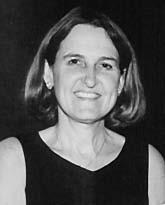
Dr.Samuel Chacko,professor ofpathology,has been invited to serve as a member ofthe Kidney,
Starting October 20,the Ryan Hospital will offer veterinary acupuncture to its companionanimal patients referred by Ryan clinicians. Currently,the American Veterinary Medical Association supports acupuncture as a complementary therapy.Acupuncture,a threethousand-year-old medical practice,has been used to successfully treat arthritis,asthma,skin conditions,diarrhea,and other conditions in people and animals.Acupuncture points are located over nerves and blood vessels.Stimulation ofthe acupuncture point with a thin needle brings about local and systemic reactions after the release ofopioids,endorphins,and chemical neurotransmitters,which can increase blood circulation,decrease pain,and improve immune function.
Corrina Snook Parsons,V’99,will accept clients on Wednesdays from 2:00 pm until 6:30 p.m.,and on Fridays from 10:00 a.m.to 6:00 p.m.Dr.Parsons received acupuncture certification in 2004 through the American Academy of Veterinary Medical Acupuncture,at the Colorado State University College ofVeterinary Medicine and Biomedical Sciences,Fort Collins,Colo.
Urologic,and Hematologic Disease Subcommittee ofthe National Institute ofDiabetes and Digestive and Kidney Diseases (NIDDK) for a four-year term.This Initial Review Group will advise the NIH director and the NIDDK director on the scientific and technical merit ofapplications for grants-in-aid for research,research training,or research-related grants and cooperative agreements,or contract proposals relating to scientific areas relevant to diabetes mellitus, endocrine and metabolic diseases,digestive diseases and nutritional disorders,and kidney,urologic,and hematologic diseases.
Thomas Van Winkle,V’75,professor ofpathology,received the 2004 Dean’s Award for Leadership in Basic Science Education.He spoke at the ACVIM Forum in Minneapolis in June on “The histopathologic classification ofliver parenchymal diseases in dogs and cats.”He also spoke at the 14th ECVIM Congress in Barcelona,Spain on September 10 on “The histopathologic criteria for evaluating hepatitis in the dog.”
Dr.Wilfried Mai,assistant professor ofradiology,received his Ph.D.in biomedical endineering. At the ACVR meeting in Montreal in August,he presented a paper,“Effects ofcardiac and respiratory motion on the spatial resolution in high-
resolution imaging techniques ofrodents.”
Dr.Cynthia Otto,associate professor ofcritical care medicine,gave a talk at the National Conference on Animals in Disaster,in Philadelphia in May,“Working with and caring for searchand-rescue dogs.”At the American Thoracic Society meeting in May in Orlando,she presented a talk,“Gene expression in macrophages exposed to intermittent hypoxia.”In September, Dr.Otto gave four talks at the 2004 IVECCS Symposium,in San Diego:“New uses for hypertonic saline in the critical patient”;“Oxygen uptake and delivery”;“What’s hot in sepsis”;and “Peer-review publications:critical evaluation and contribution.”
Dr.Pamela Wilkins,assistant professor ofmedicine,gave 10 presentations at the Society ofItalian Equine Practitioners Base Course in Equine Neonatalogy in February in Mornago,Italy.
Chick Weisse,V’98,assistant professor ofsurgery,presented two talks at the AVMA meeting in Philadelphia in July:“Veterinary interventional radiology”and “Regional tumor therapy—an approach to metastatic and nonresectable tumors.”
Dr.Corinne Sweeney,professor of medicine,came to Penn in 1978 as an intern and joined the faculty ofthe Veterinary School in 1981.Dr.Sweeney is already the recipient ofthe Norden Distinguished Teaching Award and the Veterinary Medical Alumni Society’s Excellence in Teaching Award.The Class of2003 honored her and her husband, Ray,V’82,by selecting them to deliver the Commencement Address at the Vet School.Colleagues praised Dr.Sweeney’s contributions by noting that “as a role model,she has balanced family and career with civic duties,such as her local school board presidency that shows her interest in education and teaching as wildly distributed.”A former student writes:“Although it has been over 24 years since I have been in a classroom,I can clearly recall the infectious enthusiasm for the subject matter that Dr. Sweeney brought to her teaching.There is no doubt in my mind that the career path of many ofmy classmates has been influenced and altered by the distinguished teaching of Dr.Sweeney.”Her course evaluations are
filled with superlatives:“the best professor I ever had,”“Absolutely love her! Can she teach all ofour classes?”“Without question one of the best professors I have had at Penn.”“She is superb!”A colleague concludes,“Clearly, Dr.Sweeney has demonstrated outstanding service as a veterinary educator and is truly deserving ofthe Lindback Award.”
From May until August,scrub brushes and disinfectants,rather than stethoscopes and scalpels,were the implements used by faculty and staffat New Bolton Center’s George D.Widener Hospital for Large Animals.There were no patients—just lots of people cleaning floors,walls,and ceilings and excavating barn stalls—morning,noon,and night,day in,day out.
The Hospital closed May 10 because ofan outbreak ofsalmonellosis caused by multidrug–resistant Salmonella Newport (MDR S. Newport),which was first detected in January in some hospitalized patients after tests and cultures.The Hospital took immediate steps to locate the source ofthe bacteria and to disinfect barns and treatment areas.
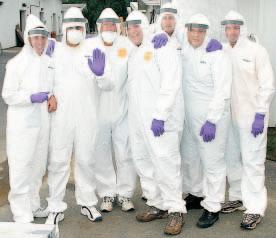
Infections continued to occur.In April, Hospital administrators decided to limit new admissions to elective procedures only.The testing and cleaning was ongoing. Clay-based stall floors in one barn were dug up and replaced, but the floors remained clear of the organism for just one week. New,highly sensitive tests revealed that more areas than originally thought showed the presence of MDR S.Newport. To protect New Bolton Center (NBC) personnel and future patients, Dean Alan M.Kelly ordered the closure ofthe Widener Hospital to all patient admissions on May 10 and the discharge ofhospitalized patients by May 15.This action allowed the Hospital staffto concentrate on
cleaning and disinfecting the Hospital spaces so the facility could be reopened as quickly as possible.

One week after the Hospital’s closure, almost all areas had been sampled at least once.A new traffic pattern had been determined,based on the identification of“clean” and “dirty”areas.Referring veterinarians were advised ofthe shutdown and provided with a list ofreferral centers in the eastern United States.By May 26,an internal biosecurity website was up and
Students scheduled for Widener Hospital rotations that were postponed were directed to other schools,or fulfilled the rest oftheir obli-
lae,infection with MDR S. Newport can be lethal,particularly in the very young,the elderly,and in humans or animals with compromised immune function.
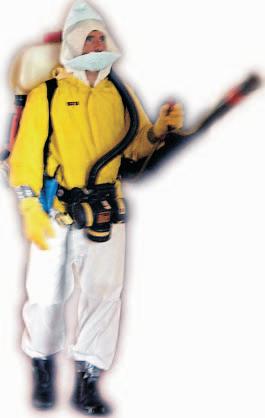 Matthew
Matthew
J. Ryan Veterinary Hospital. Associate Dean JeffWortman, worked long hours to ensure that the fourth-year students would be able to complete the rotations needed for graduation.
The disease frequently is found in dairy herds and can become endemic on farms.It has also been identified in horses,on horse farms, and at veterinary practices and veterinary schools.People most commonly contract it through handling or eating improperly cooked contaminated meat and unpasteurized dairy products,or through direct contact with infected animals.The bacterium is quite hardy and, under favorable conditions,may be able to live in the environment for prolonged periods.One additional difficulty is that apparently healthy
animals may be colonized by MDR S. Newport and can shed the bacteria in their feces,spreading the organism in barns,pastures,show grounds,and other areas.
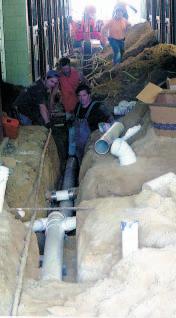
The School’s faculty and administration were well aware ofthe challenge presented to the Widener Hospital and NBC by the presence ofMDR S. Newport. “Our primary obligation right now is to ensure the safety ofour staffat New Bolton Center and to make the Hospital safe again for patients,” said Dean Kelly.“This is no easy task and it will take time.But we shall return to providing the highest quality ofcare as soon as possible.”
To proceed in the most expedient way,Dean Kelly appointed a biosecurity officer and a biosecurity committee. Helen Aceto,V’97,lecturer in epidemiology and public health,was chosen as biosecurity officer,and the committee members are David Nunamaker,V’68, Dr.Barbara Dallap,and Mr.Bruce Rappoport Their first job was to develop the protocol to eliminate MDR S. Newport from NBC while
keeping the personnel safe.Establishing procedures to prevent recurrence ofthe organism after the Hospital reopened was another important task.
“We put together an action plan,”said Dr. Aceto.“New Bolton Center encompasses almost 700 acres,more than 70 buildings,and more than 400 employees and students.So the task was huge.”An incident command structure was created,and the Woerner Amphitheater became command central. Bruce Rappoport was designated as the official spokesperson to answer questions from the media,and a news release about the closing was posted on the School’s website.The staffand faculty were kept informed through regular meetings and the School’s internal biosecurity website.Here culture results were posted,as were safety information,details about the properties ofthe various cleaning and disinfection agents,frequent updates,and pictures.The limited-access website continues to be a very efficient way to reach the entire School community.
A schedule for the collection ofsamples was
devised so that the laboratory could cope with the task,as samples had to be collected from all areas ofthe campus,vehicles,and animals to determine which areas were contaminated and which were “clean.”By early August,2,400 culture samples had been processed and read. Early on,it became apparent that only a few areas in the Hospital were affected,and a map was prepared showing contaminated areas as well as “clean”zones.This resulted in new circulation patterns,and staffwas careful to adhere to the new routes between buildings and around the NBC campus.Areas that had the greatest potential to impact human health were identified:the cafeteria (which was closed),student dorms (also vacated),and office,library,
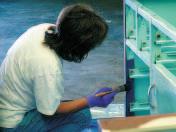
research areas.
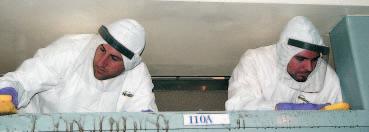
A policy was established for the handling of Salmonella-positive animals.Once it was determined that none ofNBC’s resident animals cultured positive for the organism,the School’s carriage horses could once again participate in carriage events.
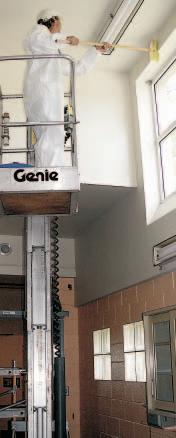
The biosecurity committee consulted with disinfection and cleaning experts and stafffrom the University’s Environmental Health and Radiation Safety (EHRS) office.A cleaning and disinfection plan was then developed.MDR
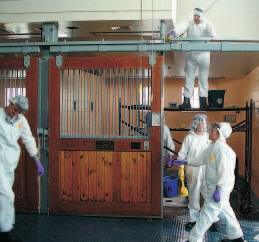
S. Newport is a tough bug. Just soap and water,even bleach,will not always kill all the organisms.In addition to being drug resistant,previous experience with cases on dairy farms indicated that this organism is resilient in the environment,so routine cleaning might not be sufficient.
“We decided to employ a multi-stage cleaning protocol that had been demonstrably effective at other institutions,”said Dr.Aceto.“It was very labor intensive and time consuming.”
While these measures were being planned, protocols had to be put into place so that the Field Service,the Georgia and Philip Hofmann Center for Animal Reproduction,and the diagnostic laboratories could keep functioning. Field Service trucks were cleaned,disinfected, cultured,and then moved to a different part of the campus,away from the Hospital.The Field Service pharmacy was relocated to a dorm room,and access to the Field Service office was changed so that it could only be entered from the southern,low-risk side ofthe campus. Veterinarians could still bring diagnostic samples to the labs,but they had to leave these at a different location,avoiding traffic through the Hospital.The School’s dairy and swine units continued to operate.The poultry diagnostic laboratory also remained open,as no
organisms had been found there.The Hofmann Center cultured negative and reopened at the end ofMay.Research continued uninterrupted in all other campus buildings,including the Alarik Myrin Memorial Research Building.
All other Hospital services were suspended.Cleaning did not just encompass the buildings;it also included all the furniture and equipment,ofwhich an astonishing amount was located in the Hospital.Areas had to be identified where objects could be cleaned and disinfected.Then space had to be cleared where these clean items could be stored temporarily.A whole Hospital full of “stuff”had to be moved! To facilitate the process,the Outpatient Clinic was stripped and cleaned and then used as an equipment staging area.Every piece ofequipment went through this area,was evaluated and either cleaned and stored or,ifnon-cleanable and oflimited value, discarded.Stored equipment was put in rented
containers placed around the Hospital complex or,in the cases ofexpensive machinery that needed careful handling and heat-sensitive material,air-conditioned areas such as the dorm rooms were used as storage sites.During the course ofthe cleanup,virtually every dorm room was appropriated for one purpose or another.
Everywhere,mats soaked with Virkon,a high-strength disinfectant,appeared.Opentoed shoes were forbidden;everyone had “New Bolton shoes”and “other-world shoes”—what had touched NBC’s grounds stayed at NBC. Because the Woerner Amphitheater was occupied by command central and the Widener conference room served as central supply for cleaning equipment and supplies,most small meetings and all large-scale meetings had to take place in other buildings on campus.All meetings at other parts ofNBC that involved Hospital faculty and staffwere scheduled for first thing in the morning,before personnel had been to the Hospital area,and everyone had to follow specific routes to come and go from the Widener Hospital.

It was hot and humid in May and June.To clean the buildings at the Widener Hospital, staffwore protective suits,goggles,face shields, gloves,and rubber boots.In some spaces,respirators were required.A,B,C,and D barns and the isolation unit were sandblasted,cleaned,
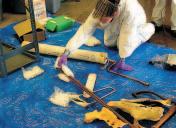
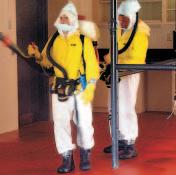
disinfected,and repainted.This process alone took about 55 days for each building.To achieve complete top-to-bottom cleaning,the stafflearned to work from ladders,scaffolds, and powered scissors lifts;they learned to handle foggers;and they became experts in all areas and surfaces that could host the organism.
Cleaning involved several steps,all of which were approved and monitored by EHRS.First,a detergent solution was used to clean the surface.During this stage, it was critical that every square inch ofevery surface be physically disrupted;this was accomplished by using a brush “no bigger than your hand,”and was the most tedious,time consuming,and exhausting ofall the stages.After a 20minute contact time,the detergent was rinsed off.Following a drying period,a quaternary ammonium disinfectant was then applied to all surfaces;initially this was done with mops but eventually a backpack sprayer was employed to make the process more efficient.The disinfectant was allowed to dry overnight before being rinsed away.The final disinfection stage involved personnel trained in wearing powered respirators and in using a gas-powered fogging
device.“Team Fogger”applied a fine mist of peroxygen disinfectant to all surfaces.Use ofa hand-held fogger allowed the disinfectant to contact all the complex surfaces and every little nook and cranny in the animal-housing andhandling areas.
Office spaces did not escape a scrubbing but went through a simplified process involving detergent,disinfectant,and rinsing steps.Desks, computers,and office furniture all were wiped down but,because doorknobs,light switches, and file-drawer pulls are “touch points,”they received special attention.
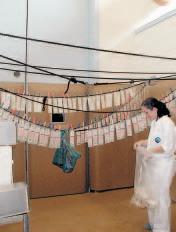
In one barn that usually housed orthopedic cases,the stalls had clay-based floors because they provide greater comfort and are easier on the horses’legs and feet than hard surfaces, such as concrete.Unfortunately,however,dirt floors are completely porous and cannot be disinfected.These,and one other clay-based stall in D barn used for housing down cows,had to be dug out,a drain system installed,and concrete poured.The decision was also made to install a monolithic sealed polyurethane flooring system in these newly poured concrete stalls,as well as in all other stalls in the Hospital.This flooring material is resilient enough to cushion the patients’feet,and it is seamless and completely bonded to the surface around drains and to stall walls,thereby providing a biosecure surface that can be cleaned and disinfected,with no nooks and crannies in
which bacteria can flourish.At the same time, all old cast-iron stall drains were replaced with stainless-steel drains for maximum corrosion resistance and longevity.All these improvements have greatly enhanced both the comfort and biosecurity ofpatient housing,but because they also take time to complete,they extended the down time for many areas beyond the original projections.
After cleaning,disinfecting,and sandblasting,all walls,doors,window frames,and stall fronts were painted with a special sealer to eliminate recesses for bacteria to hide.This work,as well as some other tasks,was performed by outside specialist contractors.Since the barns and many ofthe Hospital buildings at Widener are more than 40 years old,their cleaning and refurbishment presented quite a challenge.
New Bolton Center’s staffrose to the occasion.Everyone pitched in—and cleaned and cleaned and cleaned. People donned Tyvek® suits,climbed on scaffolding,and wielded brushes or foggers.Stalls were dug out and floor tile was taken up without complaint.“Everyone knew how important it was to get the Hospital operational again,” said Dr.Aceto.“But the New Bolton staffis fantastic;they all tackled difficult tasks that were absolutely not part oftheir job description,and the team spirit was incredible.”
On August 2,the Widener Hospital opened its doors again to a limited equine patient load. Only scheduled procedures and outpatients were seen.The caseload was restricted because only one barn was then available to house animals.The cleaning continued,and the balance
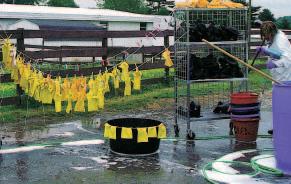
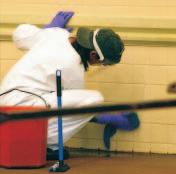
ofthe barns are still being finished.By the end ofAugust,two barns were open and the Hospital began accepting emergencies again.The C. Mahlon Kline Building and the Isolation Unit were set to open at the end ofSeptember,and by mid-October a newly refurbished outpatient area (in which flooring is also being installed) and all animal housing areas except D barn and the ICU/NICU unit should be fully open and functioning.D barn,which houses food animals and has undergone major reconstruction and refurbishment,will open shortly after that, followed by ICU/NICU.
“People worked really hard,”said Bruce Rappoport.“We could never have accomplished this so quickly ifthe staffhadn’t been so dedicated.”
Now that patients are back at NBC,some additional biosecurity measures have been implemented to protect both patients and staff and to prevent contamination ofthe premises. For example,foot mats or dip buckets with disinfectant are at all entrances to animal-housing
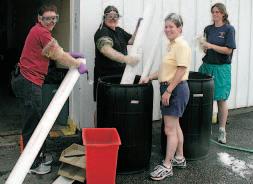
areas,and everyone must walk across/through these.Certain areas require dedicated footwear. Traffic patterns have changed,and barns must be accessed only from the front.When horses are moved from stalls,their feet must be picked; ifanimals are going to the operating room, their feet must be scrubbed.Everyone is reminded to wash hands prior to and after handling patients.Stethoscopes and lead shanks must be cleaned between patients.
All patients admitted to the Hospital are cultured to determine the presence of Salmonella organisms.Surveillance ofpatients and the Hospital environment will enable better understanding ofthe risks;thereby allowing us to make rational,evidence-based decisions on the structure and implementation ofour biosecurity program.Clients may visit their animals— with restrictions.Owners should call ahead and must check in at the front desk.They must be escorted by staffto ensure proper use ofmats at the entrance and hand washing.Ifthe animal is housed in the ICU or the colic ward,visiting,

although discouraged,must be scheduled with clinicians ahead oftime.In these areas,protective attire,special footwear,and hand washing is mandatory.Children under 12 years ofage are not permitted to visit in certain areas.Also,the Hospital grounds are off-limits to all pets;for example,dogs cannot be brought along while visiting or working there.
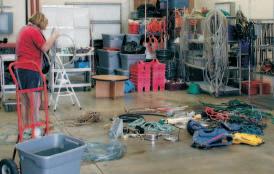
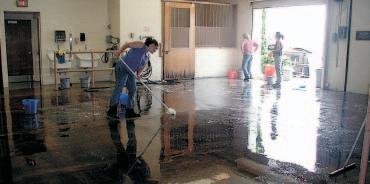
The students,too,are back at the Widener Hospital.The outbreak at the Hospital exposed them to the significance ofpreventive biosecurity measures.While they had heard lectures about the importance ofhand washing between patients and the ease with which organisms can spread,they observed firsthand the havoc a bacterial outbreak can cause.
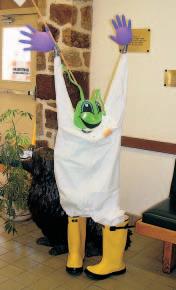
They and the students who follow them will receive a much larger dose ofinformation on biosecurity as the people and animals here were and are involved in their own case study. Widener Hospital was the patient;staffand faculty worked to heal it;and now it becomes a case study,like every other fascinating patient.
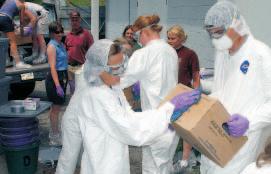
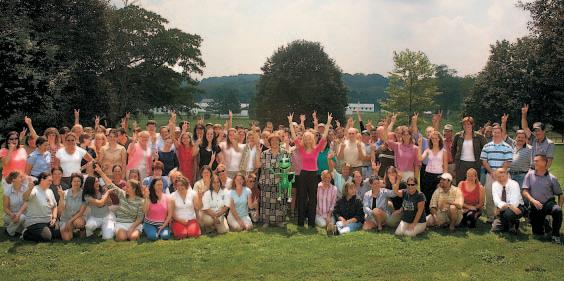

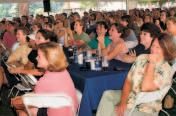
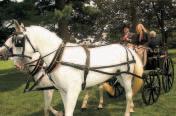
The School ofVeterinary Medicine welcomed President Amy Gutmann to NewBolton Center on August 23. Dr.Gutmann was there to thank the staff and faculty for their incredible efforts to reopen the Widener Hospital just three months after its closure on May 10 due to an outbreak ofmulti-drug–resistant Salmonella Newport.During a luncheon hosted by Dean Alan Kelly,Dr.Gutmann presented the Veterinary School staffand faculty with the University’s Commitment to Excellence award—part ofa new recognition program at Penn.Dean Kelly recognized the extraordinary efforts that went into eliminating the Salmonella threat so rapidly, and so the University nominated the staff and faculty for the award.

This past summer was eventful for our Veterinary School and for our future with it. Many events—some past but most still to come—will affect us as alumni.
The temporary closure ofNew Bolton Center was serious in its impact.Making sure that it was disinfected and Salmonella-free for its reopening was a tribute to the tenacity of the School’s faculty and staff.In a day and age when “whitewash”is a chosen color and “spin” is the explanation ofchoice,neither ofthose activities was in evidence during the closure.The spirits ofhonesty,truth,and candor enveloped the School, from Jacques Jenny,Bob Brody,Joan O’Brien, Bill Boucher,Eric Tulleners,and many more I never knew,smiled broadly as we did “the right thing”—and spent a lot ofmoney doing it.New Bolton Center is back,it is better,and you should be proud ofhow this event was handled.
I am also pleased to share with you news that the School will establish listservs this fall for each class up to the 50th reunion class and one for all alumni who graduated 50 or more years ago.The listservs will allow class agents or any class member to send a message to their entire class by using only one email address. The service will be offered free,and you will receive subscription information later this fall. Ifthe School does not already have your email address,get it to them.Life is too short not to be in contact with the people who have journeyed with us on what may have been the most formative four years ofour lives.Keep in touch with your class and your School;we are all better for it.
James V.Stewart,V’68, President,Veterinary Medical Alumni Society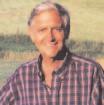
Lastly,we still have the “money”thing.The Kresge Foundation has challenged the School’s alumni and friends to raise $13 million by October 1,2005 to earn a grant of$1.5 million.
This is an all-or-nothing challenge:one dollar short,no Kresge money is given.Ifyou have ever considered increasing your support or even making your first donation,now is the time to do it! Ifyour clients have ever thought ofmaking a gift to the School,now is the time to approach them.All gifts and pledges to the School will count;will your commitment be the one that triggers the $1.5-million windfall?
Let me close by saying that I had the pleasure to address the first-year class during New Student Orientation in late August.I met many bright,optimistic,and eager young people,just like we were.I told them we knew what they were facing and would help in any way.I closed by telling them they were at the best veterinary school in the world,a legacy they should never forget.They applauded.It doesn’t get any better than that!
In other news,the ground has been broken, the foundation is being laid,and the new Teaching and Research Building is starting to take shape.Our ability to provide a top environment for our students and for talented teachers doing research will rise.As in the past, Penn Veterinary Medicine will draw the great young people who ensure our future as scientists,veterinarians,and animal lovers.That is how it has been and how it must always be to keep our place in the academic world ofthe future.
A year ago,at the beginning ofthis great experience as President ofthe Veterinary Medical Alumni Society,I said that I wanted the School’s interns and residents to be included in our alumni family.It is officially acknowledged they do hold alumni status.Now,we need their contact information for the School’s records. The Office ofDevelopment and Alumni Relations and many ofus are trying to track them down.Ifyou have contact information for any intern or resident,please send it to Joshua E. Liss,Director ofAlumni Relations and Annual Giving,at <lissj@vet.upenn.edu>.
In the fiscal year that ended June 30, 2004,alumni rose to the generous challenge of Laurie J.Landeau,V’84 WG’84.If alumni contributed a total of$150,000 in new and increased gifts to the Veterinary Student Scholarship Fund,Dr.Landeau would contribute $150,000 to the School. In issuing her challenge,Dr.Landeau said, “Our School depends on the generosity of each and every one ofus,no matter the level ofour giving,to ensure that the next generation ofV.M.D.s carries Penn’s excellence into the future.”
Alumni were clearly inspired by Dr. Landeau’s challenge,as 727 ofthem contributed more than $155,000 in new and increased gifts.Ofthose alumni,472 had not made a gift to the Veterinary Student Scholarship Fund in the previous fiscal year.The new donors also included 68 members ofthe Class of2004 who made a gift even before they graduated from Penn.
According to Dr.Landeau,“I was overwhelmed not only by the warm response from our alumni,but also by the reaction ofcurrent students.It is astonishing how many ofthe senior class came through with personal donations.Numerous stu-
dents from all classes have stopped me to tell me personally how much they appreciated having someone offer this opportunity both to raise awareness ofthe critical need for more tuition aid and to increase the level ofalumni generosity at the same time.One,a first-year Phone-a-thon caller, told me that being able to use the Landeau Challenge made her job so much easier— but she wanted to know where we would find someone to offer a similar challenge in the new fiscal year! Fortunately,we do have a challenge to encourage even more involvement via the recently awarded Kresge Foundation Challenge Grant.”
Dr.Landeau,chair ofthe School’s $100-million fundraising campaign, Building New Levels ofExcellence,is optimistic that the response ofalumni to her challenge bodes well for the School in meeting the conditions to earn the Kresge challenge grant of$1.5 million for the new Teaching and Research Building.As of August 31,to obtain the grant funds,the School must raise $10 million for any initiative or priority from its alumni and friends by October 1,2005.
Society has engineered the practice ofveterinary medicine as far back as the scripting ofthe Code ofHammurabi,which set forth certain practices for the profession.While veterinary medicine has had an impressive run over the 40 centuries that have followed,it’s been a marathon—evolutionarily speaking—compared with the sprinter-paced changes ofthe past halfcentury.
Three alumni celebrating reunions in 2004 discuss the transformations and trends they have witnessed in their field since they graduated 50,25,and 10 years ago,respectively.They also reflect on their own careers and postulate on future directions for veterinary medicine.
Robert D.Flowers,V’54,is a retired smallanimal practitioner from Mechanicsburg,Pa.A Philadelphia native from a broken home,he was sent at the age ofnine to The Church Farm School in Paoli,Pa.,a boarding school,where he became instantly drawn to working with animals.After finishing in the armed services in 1946,Flowers enrolled in Pennsylvania State University’s pre-veterinary program.He entered mixed-animal practice shortly after veterinary school,but eight years later switched to small-animal medicine.He sold his practice four years ago at the age of75.
Joan Regan,V’79,is a staffradiologist at Angell Animal Medical Center in Boston. Though an English major at Mount Holyoke College,she enjoyed biology and thought veterinary medicine would be a nice alternative to publishing.Regan graduated from Penn Veterinary Medicine’s first class to be comprised of equal numbers ofmen and women.She completed a field-service internship at the University ofCalifornia,Davis,School ofVeterinary Medicine,and then spent 11 years in mixedanimal practice in Massachussetts.At the age of 40,Regan launched a new career path,returning to Penn for a residency in radiology.After completing her residency,she remained at Penn for two years as a lecturer before going to Angell.
Steven P.Cudia,V’94,owns a mobile surgery practice in Toms River,N.J.Growing up the son ofa physician father and a mother who nurtured her boy’s love for animals,he majored in biology at the University ofScranton.After earning his veterinary degree,Cudia started out in mixed-animal practice.Shortly afterward,he completed an internship at Penn followed by an emergency-medicine and surgery internship at Garden State Veterinary Specialists in northern New Jersey before going to work for a large referral practice nearby.Cudia began his mobile practice five years ago.His caseload,which consists primarily ofadvanced surgeries,is heavily weighted toward orthopedics.
All three comment on their career choices: Flowers,like most ofhis classmates,started his own practice shortly after graduating.He worked seven days a week and was always available for emergencies.“When you’ve chosen general practice,” he reasons,“it becomes a large part ofyour life.” Given it to do over,he says he would change nothing.
Regan says she left mixedanimal practice after more than a decade largely because it became tedious to her.Also,she grew impatient with noncompliant owners.Influenced by both veterinary (W.Harker Rhodes,V’55 GV’58) and human radiologists whom she’d befriended,Regan,an admitted “detail person,”pursued a specialty in radiology.“I decided I’m much better ‘behind the scenes.’”
She says ifshe could relive things,she would have pursued veterinary radiology from the start.
Cudia took his love ofsurgery to the hilt by mastering complicated procedures and making them his life.“I figured that knowing a little about a lot was not going to be enough in today’s society.I wanted to know a lot about a little.”
He enjoys the independence and flexibility ofhis mobile practice,which serves six or so core clinics within a one-hour radius ofhis home.Working Mondays through Thursdays
from 8:00 a.m.to 6:00 p.m.,he says,“I make my own schedule and I make my own rules.”
Though he’d once considered a career in emergency medicine,Cudia,whose father was an obstetrician/gynecologist,decided that it would restrict his personal life too much.“The old,‘Where’s Dad?’phrase kept running through my head,”says Cudia,who is married with three children.“I knew I wanted veterinary medicine to be part ofmy life but I knew I didn’t want it to be my life.”
…On how their eras impacted the veterinary profession:
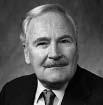
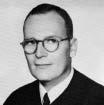
A self-described “Depression child,”Flowers says very few small-animal practices were around in the 1930s and ’40s.The veterinary profession existed mainly to serve agriculture. But right after World War II,people began moving from farms to cities.As society became more affluent,families brought pets into their lives.“This,”he recalls,“was the revolution of small-animal medicine.”
He adds that the veterinarians ofhis time worked hard to combat public ignorance ofpet health.“Our generation really educated the public about good veterinary medicine.When I started in practice,the number ofpeople who didn’t take their pets to the vet far outnumbered those who did.”By educating pet owners about veterinary-health measures like vaccination (he estimates that fewer than 10 percent of pets were vaccinated when he started out in practice),he says,“We made a lot ofmoney for the veterinarians oftoday.”
Cudia says that a new class ofcustomer, armed with information sources like the Internet,provides fresh challenges for veterinarians. “People have really come to demand a lot from whatever service they are patronizing,whether it’s the department store,the gas station,or the veterinarian.”
Add to this the fact that pets have become a bigger part ofpeople’s lives:“All the expectations they have for their child’s welfare and medical care they also have for their pet’s.”
…On how the practice ofveterinary medicine has changed during their time in practice:
“When I started school,I didn’t even know they treated small animals.Ifa dog got sick, they just wormed it,”says Flowers.
Medical advances kept pace with society’s
increasing willingness to participate in their pets’healthcare.Flowers says that throughout his career,the rate ofprogress ushered in major advances every five or so years.
“By the time I left practice,” says Flowers,“we were doing things that we couldn’t possibly do when I first graduated.”
He recalls learning how to run EKGs in school,“but we were told we would probably never have to use them.”Gas anesthesia was unavailable.ACL ruptures were managed by “firing the knee”with a hot rod rather than performing surgical repair.
Regan says new diagnostic technologies brought unprecedented sophistication to veterinary medicine.Whenever she peruses old films filed at her hospital,she says,“I’m reminded how much easier it is to make diagnoses now than when we didn’t have ultrasound or CT.Ifyou have a more accurate diagnosis,you can treat it correctly rather than just wing it.”
The biggest change Cudia has seen since he graduated ten years ago is the greater accessibility ofspecialty care.“People used to struggle to find places to have radioactive iodine treatment for their cats.Now they can drive 30 minutes for this.They can get an MRI any day ofthe week and they can see an oncologist 24/7.”
…On specialization:
Though it seems to have hit our profession with hurricane force,the trend toward specialization was actually very plodding.It’s a development that Flowers first took notice ofin the 1960s.“We gradually started to see specialists and emergency clinics,”he recalls.
But their scarcity rendered it difficult to refer clients to them,adds Flowers,who took courses to learn how to perform certain “specialty”procedures like ophthalmologic services and orthopedic surgeries.By the early 1970s, improved accessibility to specialty care made it easier for him to refer such cases.
While specialization has been a boon to the profession,Regan has her concerns.“A lot of
these people,instead ofstaying at a university and training other people,go offinto private practice,where there’s more money to be made,”she observes.“No one’s staying back to teach.”
“In radiology, there are schools that don’t know who is going to train the next group ofradiologists.”
…On emerging diseases through the years: While most changes in our profession seem to have been propagated by people— veterinarians or owners—some have been initiated by Mother Nature.
For instance,notes Flowers,“We learned about heartworm in school,but we were told it was a tropical disease.”And it very well may have been,then.
Distemper,on the other hand,ran rampant. Yet by the time Regan graduated 25 years later, it had been nearly eradicated through vaccination programs.Parvo,however,was coming of age.“One virus goes out and the other comes in,”Regan says.“It’s a constant parade.”
…On changing dynamics between the pet owner and the veterinarian:
“A lot ofpeople think oftheir pets as family members or children,”says Regan.

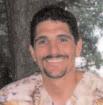
No one can deny the virtues ofthe human–animal bond.Yet this bond holds the potential to negatively impact the profession.
“There are inklings ofthe concept that we are ‘guardians’ofanimals rather than ‘owners,’”says Cudia.The possible legal ramifications,he explains,will certainly place additional pressures on veterinarians.
The bar is also raised by the fact that owners are more informed about medical issues today than they were in the past.“Just the other day,
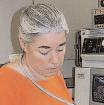
someone asked me how stem cells would influence veterinary medicine,”says Flowers.“In the 1950s,they just wanted to know how to get rid ofhookworms.”
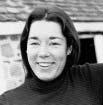
…On other significant trends impacting the profession:
Flowers,whose practice was sold by a subsequent owner to a corporation,decries corporate ownership ofveterinary hospitals.Corporations,he says,“are greedy.They don’t really care about practicing good,quality medicine.”
Ofconcern to Cudia is proposed legislation to allow non-veterinarians to treat animals without veterinary supervision.
The animal-rights movement and zoonotic concerns are two forces that will continue to affect the veterinary profession,predicts Regan. Ofthe latter,she says,“Public health threats, real or imagined,have put veterinarians in a positive light as being the people who know what those risks are and can translate them for society.”
…On their hopes for the future ofthe profession:
Flowers would like to see an influx ofcentralized community animal hospitals,similar to those on the human side.These,he explains, would allow veterinarians to more efficiently deliver quality medicine by sharing equipment and overhead costs.
His wish for veterinary education is that the specialties continue to grow,but that veterinary students—who he believes often try to narrow their focus prematurely—continue to take the core curriculum seriously.As a former member ofthe Pennsylvania State Board ofVeterinary Medicine,he recalls comments by students to whom he administered board exams.“They would say,‘I’ll never use this anyway.’And then they would end up using it.”
Cudia,who hopes to devote the next 30 or 40 years to surgery specialty practice,agrees that young veterinarians should keep open minds.“There are always alternatives and you have to feel free to break from tradition.”
It all started with a small package that came in the mail.From there,followed a brilliant idea.And then the leading cyber-trove ofrunning veterinary info,the Veterinary Information Network (VIN),was launched.
Duncan C.Ferguson,V’79 GR’82,who cofounded the online veterinary knowledge base, remembers the parcel he opened one day in 1989. It held a floppy disk,and he started answering the questions it contained on pet health from the users ofQuantum Computer Services,an online bulletin board system,which was later renamed America Online.Before long,he was running America Online’s pet care forum.
He soon met Dr.Paul D.Pion online,then a veterinary cardiologist at the University ofCalifornia,Davis,School ofVeterinary Medicine. The two discussed online outreach to the veterinary community.
“Ifwe could do it with music,sports,and entertainment,”reasoned Ferguson,professor of physiology and pharmacology and ofsmall-animal medicine at the University ofGeorgia College ofVeterinary Medicine,“then why couldn’t we be doing it with veterinary education?”
And so VIN was born.The independent network,which grew from just 200 members in 1992 to some 19,000 today,had a three-fold goal.First,it would provide what Ferguson calls “information insurance”to the private practitioner.For a monthly fee,veterinarians could access veterinary health news,take part in weekly rounds,and utilize an expansive database.
Second,it would build community.“We did it to bring veterinarians together and improve the profession,”says Pion,president ofVIN.
VIN,he explains,has transformed structured learning into a daily event for doctors,as opposed to the monthly or annual event offered by the conference format.
“Duncan and I are firm believers that education has to become part ofyour life.It’s an every-moment event.”In contrast to a meeting, Pion says,VIN offers access to specialists available to answer questions,and chat rooms where information can be traded.
Adds Ferguson:“It’s an effective mode of tackling universal quandaries—the old ‘Yeah, that’s just like a case I saw the other day.’”
Third,the new service would provide another mode by which subscribers could earn continuing-education credits.While Pion focused
on building the business,Ferguson,who sold his share ofthe Davis,Calif.-based company to his partner six years ago to focus exclusively on his research and teaching obligations,spearheaded the education piece.But the veterinary state boards were a force to reckon with:many, Ferguson remembers,refused to offer credit for computerbased education,insisting on meeting attendance instead.
“We are a very conservative profession,”Ferguson reasons. “But the reality is that there is a legitimate learning process going on here,and there’s no difference between distance learning and on-site learning.”
Yet meetings are moneymakers for the state boards. “We tried to tell them these were two different populations, and that people would still attend meetings.”
Despite the obstacles,Ferguson and Pion proceeded with the CE program,which brought specialists and consultants—whom they paid hourly—into the VIN loop.
A specialist himself,Ferguson,who is a diplomate ofthe American College ofVeterinary Internal Medicine and the American College ofVeterinary Clinical Pharmacology,is a strong proponent ofup-to-the-minute,benchto-bedside medicine.
Growing up in a Connecticut suburb,he had pets as a child.But his interest in veterinary medicine did not solidify until his junior year at Dartmouth College,where he majored in chemistry. Accepted into medical school and Penn Veterinary Medicine,he chose the latter for its invitation into the combined V.M.D.-Ph.D.program.
Ferguson’s career choices were further solidified by the arrival ofan apparent newcomer disease to veterinary medicine—hyperthyroidism—which evidently began cropping up in cats toward the end ofhis time in veterinary school.
Ferguson completed his doctoral degree in pharmacology with a concentration in thyroid hormone metabolism.The Penn Medicine lab where he worked,while practicing part-time at a local emergency clinic,developed thyroid hormone assays for use in people,and studied the basic aspects ofthyroid hormone metabolism.
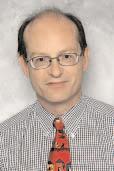
“I really bought into the idea of‘One Medicine,’”he says.“We see a lot ofspontaneous dis-
ease in animals that reveals many things about the human condition.”
He points out several human diseases where progress can be made by studying corresponding or associated veterinary models.These include Alzheimer’s,Parkinson’s and Cushing’s diseases,the latter occurring some 20 times more frequently in dogs than in people.
After earning his doctorate, Ferguson crossed back over 38th Street for a residency in small-animal medicine.Today, he runs a lab at the University ofGeorgia,where he studies thyroid hormone metabolism and action,sequences the molecule thyrotropin (TSH),and develops TSH assays designed to screen for disease before the animals become clinical.
Ferguson,50,also collaborates with his wife, Margarethe E.Hoenig,GR’84,who performs diabetes research across the hall from him at UGA.The pair,who have two grown daughters and live in Athens,Ga.,met at Penn while Duncan was working in the lab and finishing his clinical rotations and Margarethe was doing a residency in small-animal medicine.
Although he spends halfhis time in the lab, with much ofthe rest devoted to professional and graduate teaching,he stays close to practice.“Clinical relevance is very important to me, which is why I have always kept my hand in thyroid diagnostics,”says Ferguson,who heads a recently funded initiative to develop a D.V.M.Ph.D.program at UGA.
He adds that the clinical perspective is also a strong component ofhis student lectures.And so are a few tricks he learned while developing a practitioner-friendly format for VIN.“It changed the way I did things in the classroom.I became much more interactive,”says Ferguson, who also created an interactive online education program at UGA.
Ofthe interrelated twists and turns in his career,he observes,“In these last 20 years I’ve become an ‘uberspecialist’in clinical pharmacology and endocrinology.But I was very drawn to the intellectual interchanges we initiated on VIN—there’s a truly fine line between what I do in the lab and the logic ofmaking a medical diagnosis in the clinic.”
During the annual meeting ofthe American Association ofAvian Pathologists at the American Veterinary Medical Association Annual Convention in July 2004, Stephen B.Hitchner was honored with the Bruce W.Calnek Applied Poultry Research Achievement Award.The award is given to a member ofAAAP who has made outstanding research contributions resulting directly or indirectly in a measurable,practical impact on the control ofone or more important diseases ofpoultry.
To find a former classmate and to sign up for a permanent email forwarding service:
Join the University ofPennsylvania Alumni OnLine Community for free at <www.alumni connections.com/olc/pub/UPN>.After you register,you can search the On-Line Directory,which is a great resource for personal and professional networking and an easy way to keep up-to-date on fellow alumni.You can also sign up for a permanent email forwarding service,which will forward messages received at your permanent Penn address to the email address ofyour choice.
To update your alumni record:
You can update your record via the University of Pennsylvania Alumni On-Line Community OnLine Directory.You may also contact Elizabeth McNamara at (215) 746-7461 or via email at <emcnamar@vet.upenn.edu>.
To make a gift or for information to support Penn Veterinary Medicine: Make a gift with your credit card through a secure online transaction at <www.upenn.edu/gifts>.For information on supporting the School,visit the Alumni & Friends website at <alumni.vet.upenn. edu> or contact Joshua E.Liss at (215) 898-1481 or via email at <lissj@vet.upenn.edu>.
To request a transcript,certification of graduation, or replacement diploma: For information on requesting a transcript,visit the Office ofthe University Registrar’s website at <www.upenn.edu/registrar/transcripts/ transcripts.html> or call (215) 898-7511.For information on requesting a certification ofgraduation,which does not require a transcript,contact the School’s Office ofStudent & Curricular Affairs at (215) 898-3525 or via email at <studentaffairs@vet.upenn.edu>.For information on ordering a replacement diploma,visit the Office of the Secretary’s website at <www.upenn.edu/ secretary/diplomas/#replace>.
To post/search employment opportunities for veterinarians: Visit the School’s Veterinary Employment Database at <www.vet.upenn.edu/jobsearch>.
During the Delaware Veterinary Medical Association’s annual meeting in April 2004, Robert L.Ricker was honored with the 2003 Veterinarian ofthe Year award.Former state veterinarian and private practitioner,he is a past president ofthe DEVMA and has served on the Delaware Board ofVeterinary Medicine.Although retired,Dr.Ricker continues to serve Delaware as a bioterrorism representative and as an administrator ofthe newly formed Johne’s disease control program.
Eugene Witiak has recently published a book of vignettes and personal commentary, True Confessions ofa Veterinarian: An Unconditional Love Story According to the publisher,“Dr.Witiak’s stories of the bond between the veterinarian,client,and pet take the reader into the exam room and on house calls to experience the laughable calamities,miscues, and surprises as well as the personal sorrows,revelations,and joys that treating animals can bring.”For more information or to order the book,visit <www.glenbridgepublishing.com>.
To purchase veterinary,medical,and alllied health textbooks from leading publishers: Visit the Penn Vet Bookstore at <www.vet.upenn. edu/studentaffairs/bookstore>.A percentage of purchases is returned to the School in the form of scholarship funding to deserving veterinary students.
To obtain a Penn Alumni Card:
The Penn Alumni Card offers a myriad ofbenefits, including access to the Penn Libraries (does not include borrowing privileges or access to online resources) and discounts on admission to the Morris Arboretum,Class of1923 Ice Rink,and University ofPennsylvania Museum.The charge for the card,which is valid for 10 years,is only $20. For more information,visit <www.upenn.edu/ penncard/card/obtain_alumni.html>.
Joshua E.Liss
Director ofAlumni Relations and Annual Giving
(215) 898-1481
Fax (215) 573-3544
Email <lissj@vet.upenn.edu>
Elizabeth McNamara
Annual Giving Coordinator
(215) 746-7461
Fax (215) 573-3544
Email <emcnamar@vet.upenn.edu>
Please address any correspondence to: Office ofDevelopment and Alumni Relations
University ofPennsylvania School ofVeterinary Medicine
3800 Spruce Street
Philadelphia,PA 19104-6047
During the North Carolina Veterinary Medical Association’s annual meeting in June 2004, Richard A.Mansmann was honored with the Martin Litwak Award for his contributions to the North Carolina State University College ofVeterinary Medicine and the veterinary profession in the state.Dr.Mansmann is a clinical professor and director ofthe Equine Health Program at NC State,and also owns Central Carolina Equine Practice in Chapel Hill.
1973
Nancy O.Brown,a member ofHarcum College’s Board ofTrustees since 1997,has been recently elected Vice Chair ofthe Board.Located in Bryn Mawr, Pa.,Harcum is a two-year,private women’s college that offers programs in the health sciences,liberal arts and sciences,and business and professional studies.Dr.Brown owns Hickory Veterinary Hospital in Plymouth Meeting,Pa.
1979
Edgar J.Balliet III was profiled in The Morning Call ofAllentown,Pa.,on May 28,2004.His wife, Gay,has written three books about the couple’s experiences together.Her most recent book is Lions & Tigers & Mares ...Oh,My! According to the publisher,RDR Books,“[Gay’s] travels as assistant to her husband,a large animal veterinarian,take her along the colorful back roads ofthe Pennsylvania Dutch farm country as well as backstage at circuses,game preserves,and even TV shows.”Dr.Balliet’s practice is located in Northampton,Pa.,and 80 percent ofhis patients are horses.
Robert J.Washabau has recently left Penn Veterinary Medicine for the University ofMinnesota College ofVeterinary Medicine where he will serve as a professor ofmedicine and chair ofthe Department ofVeterinary Clinical Sciences.
Robert S.Kieval is President and CEO ofCVRx, Inc.,located in Maple Grove,Minn.,which is developing therapeutic medical devices for cardiovascular markets.
Patrice Noelle Klein has been named team commander ofVeterinary Medical Assistance Team-2, which is based in Maryland.Highly trained teams composed ofveterinarians,veterinary technicians, and support personnel,the VMATs provide veterinary medical treatment and address animal and public health issues resulting from natural,man-made, and technologic disasters.Dr.Klein is a senior staff regulatory veterinarian with the U.S.Food and Drug Administration’s Center for Food Safety and Applied Nutrition.
In celebration ofthe 100th birthday ofthe ice cream cone, The News Journal ofWilmington,Del. featured the Woodside Farm Creamery on August 26, 2004.Owned by Janet Mitchell and her husband, Jim,the creamery is located in Hockessin,Del.,and is open April–October.According to Dr.Mitchell, “What make us unique is the atmosphere—people love to come in the evening and sit outside eating an ice cream cone while their kids can run around and see the cows and the farm.”Dr.Mitchell practices at Hockessin Animal Hospital.
Patricia M.Hogan was honored with a President’s Award from the American Veterinary Medical Association during its Annual Convention in July 2004.The award recognizes individuals and groups inside and outside veterinary medicine who have made an impact on animal,human,or public health;veterinary organizations;and the profession.Dr.Hogan treated Smarty Jones after he suffered a potentially career-ending injury.
Roy P.E.Yanong has been promoted to associate professor at the University ofFlorida’s Institute ofFood and Agricultural Sciences.Based at the Tropical Aquaculture Laboratory in Ruskin,Fla.,Dr.Yanong provides on-site veterinary assistance as well as diagnostic laboratory support,including water quality,necropsy,and microbiology for fish producers in the area.
Laurie Bergman is a new diplomate ofthe American College ofVeterinary Behaviorists.She is in charge ofthe Behavior Service at the University of
California Veterinary Medical Center—San Diego,a joint venture ofthe University ofCalifornia,Davis, School ofVeterinary Medicine and the University of California,San Diego.Dr.Bergman and her husband, Stephen Long,V’91,welcomed their first child,a son, Daniel Owen,in December 2003.
Cynthia S.Dahle was featured in The Star Democrat ofEaston,Md.on September 8,2004 about her use ofacupuncture in her practice at Bay Area Veterinary Hospital in Stevensville,Md.According to Dr.Dahle,who is a certified veterinary acupuncturist, “Most conditions can be helped or treated by acupuncture.”
Karen M.Froberg-Fejko and her husband, Michael,are proud to announce the birth oftheir son,Colton Michael,on February 7,2004.As ofJuly 19,2004,Dr.Froberg-Fejko assumed a new position as president ofBio-Serv,a company in Frenchtown, N.J.,which serves the pharmaceutical industry.
Sharon D.Gottfried is a new diplomate ofthe American College ofVeterinary Surgeons.Dr.Gottfried practices at Veterinary Surgical Associates in Concord,Calif.
David Adam-Castrillo is a new diplomate ofthe American College ofVeterinary Surgeons.
Heather Peikes was profiled in the New York Post on July 13,2004.The only board-certified veterinary dermatologist in New York City,she recently opened a new practice,Animal Allergy and Dermatology. According to Dr.Peikes,“People laugh when you mention dogs have allergies,but when you have a dog with allergies and it’s sleeping with you and up all night,licking its paws,itching and keeping you up, it’s not good for the dog and it’s not good for its owner.”
Akiko Sato is a new clinical veterinarian in the Stanford University School ofMedicine Department ofComparative Medicine.
Tracey Anne Hall is very happy to announce her marriage to Peter Thomas Schiron,Jr.on September 25,2004 on Nantucket Island,Mass.Peter and Tracey met in the Caribbean two years ago and now live on Manhattan’s Upper West Side.Tracey practices smallanimal medicine and surgery on Manhattan’s Upper East Side,and Peter is an attorney with Deloitte & Touche’s Office ofGeneral Counsel in Manhattan.
They both enjoy life in the big city and continue to explore new islands together.
Margaret C.Mudge,a resident at the University of California,Davis,School ofVeterinary Medicine,was featured in an article about her treatment ofa horse with sand colic in the July 2004 issue of EQUUS magazine.
1996
Julianne E.Grady,a daughter,Cadence Paige,on February 20,2004.
Correction: Jennifer A.Morris,V’99,gave birth to a son,Calvin Robert,on January 25,2004.
1936
Albert L.Opp on April 22,2004.
1939
Patrick F.Cosgriff on June 13,2004.
Thomas A.Ladson on January 23,2004.
1943
George N.Wade,Jr. on August 4,2004.
1945
Charles F.Thumm on July 11,2004.
1946
Elmer B.Kipp on July 5,2004.
1955
John D.Beck,Jr. on April 6,2004.
Share news with your classmates about a new position or accomplishment,wedding,or birth announcement by sending your class note today! We accept pictures,too,featuring alumni gatherings,whether it’s from a wedding or minireunion.Be sure to identify everyone in the picture.Pictures will be returned only upon request. Send all your submissions to:
Joshua E.Liss
Director ofAlumni Relations and Annual Giving University ofPennsylvania School ofVeterinary Medicine 3800 Spruce Street Philadelphia,PA 19104-6047
Fax (215) 573-3544
Email:lissj@vet.upenn.edu
THE FOLLOWING MEMORIAL AND HONORARY GIFTS WERE MADE TO NEW BOLTON CENTER
In memory of a special person:
Stacey Lyn Conarello,V.M.D.in memory ofJosh Aidan Foster
Ms.Janeth A.Martin in the name ofSt.Anthony,the protector ofanimals
In honor of a special animal:
Ms.Eileen M.Corl in honor ofWiley’s Claddagh “CLOVER”
Ms.Sarah E.Reese in honor of“BART”
In memory of a special animal:
Mr.and Mrs.Michael R.Bingeman in memory of“TROIKA”
Mr.and Mrs.David L.Carr in memory of“TROIKA”
Ms.Brenda J.Fessler in memory of“BARNEY”
Mr.and Mrs.Roland W.George in memory of“TROIKA”
Susan G.Emeigh Hart,V.M.D.,Ph.D.in memory of“BELLA”
Ms.Fay L.Hildebrandt in memory of“UNCORK THE MAGIC”
Ms.Sybil B.Howard and Flintrock Stables in memory of“TROIKA”
Mr.and Mrs.Mark E.Scherer in memory of“TROIKA”
Mr.and Mrs.Gregg Schierl in memory of“TROIKA”
Mr.and Mrs.Michael D.Shireman in memory of“TROIKA”
To the Equine Research Fund by the following:
Mr.and Mrs.Edward W.Bauman
To the William & Doris Boucher Endowed Scholarship Fund:
Mrs.Doris A.Boucher Ritter
To the Eric Tulleners Memorial Scholarship Fund:
Sean A.Maguire,V.M.D.in memory ofDr.Eric Tulleners
To the “LORD ASHLEY”Fund in his memory:
Ms.Gina Santorio-Sontarp
To Dr.Virginia Reef’s Research Fund:
Alchon Family Foundation in memory of“LEGIT”
Ms.Deborah A.Learn in memory of“LEGIT”
THE FOLLOWING MEMORIAL AND HONORARY GIFTS WERE MADE TO THE MATTHEW J.RYAN VETERINARY HOSPITAL OF THE UNIVERSITY OF PENNSYLVANIA
In memory of a special pet:
Sean and Michelle Anderson in memory of“IGGY”
Rick and Risa Armstrong in memory of“AXEL”
Deborah Phillips Aronson,V.M.D.in memory of“SAMSON”
Arthritis and Osteoporosis Center,Inc.in memory of“MOLLY”
Patricia Ashe in memory of“ARIEL”
Steven L.Beauchene in memory of“ELMO”
Stephen F.Bezuk in memory of“MISTY”,“MIDNIGHT”,and “MR. BAD”
Mr.and Mrs.Robert Cary in memory of“CASEY”
Mr.and Mrs.Gene Cianfrana in memory of“REGGIE”
Lillianne M.Ciasullo in memory of“MAC”
Lydia D.Damato in memory of“NIKKO”
Ms.Irene Decker in memory of“DILLON”
Teresa A.DeMusis in memory of“JINGLES”
Helen W.Depenbrock in memory of“ABBY”and “WINDSOR”
Carmen F.DiBiaso RET AFCMS in memory “MOXIE”
Stephanie and Bob Dickson in memory “BO”
Helene,David,and Thomas DiVito in memory of“SHELBY”
Barbara Ellis and Hans Borov in memory of“ADDIE”
Karen Fernsten and Nancy Rufin memory of“MAX”,“BORIS”,and “TEDDY”
Jane Furlong in memory of“ALEX”
Marcy Gallagher in memory of“TOBY”
Erika Gorn Georgoffin memory of“CODY”
Vincent and Nancy C.Gioia,Jr.in memory of“CHLOE”
Barbara and Scott Green in memory of“PEARL”
Michele Hamilton in memory of“SCHROEDER”
Robert B.and Patricia A.Hazelton in memory of“MORGAN”
Wilson and Carolyn Hipley in memory of“PAL”,“MAJOR”, “GARETH”,“PHELAN”,& “NICCI”
William R.Hoffman in memory of“CHACO”
Mary W.Holben in memory of“McKEEVER”and “P.T.”
Mark Hullstrung in memory of“MISSY”
Jessica W.Jerrard in memory of“BOOKSTOR ORION AT MAJENKIR”
Marcy Kjeldsen in memory of“HUXLEY”
Alexandra B.Knox in memory of“MOAK”
Joanne M.Kolen in memory of“MAX”and “MEGGIE”
Arlene Kress in memory of“CORKY”
James and Kathryn LaBar in memory of“DRAKE”
Bernadine Lennon in memory of“NINJA”
Rosalie Greenfield Matzkin in memory of“RALPH”& “BUSTER”
Kathy McGeorge in memory of“TAFFY”
Maureen P.McKew in memory of“SAMSON”
David and Barbara Mealmaker in memory of“MARKITA”
Annette F.Moskowitz in memory of“JESSIE”,“SAMANTHA”,& “BEAMER”
Sam and Nadine Mullay in memory of“SNICKERS”
Mary Alice Musser in memory of“LILY”& “CHANCE”
Mr.and Mrs.Robert Nicholson in memory of“SMOKEY”
Denise Pascucci in memory of“GALAHAD”
Cindy Jo Pauley in memory of“GATSBY”and “RAVEN”
Rose Piccora in memory of“PATCHES”
Mary Jo Robinson,D.O.in memory of“SARAH”
Gregg A.Runyen in memory of“MEGGIE”& “JESSIE”
Joan T.Sargent in memory of“MEG”
Mary and Bob Sarkisian in memory of“PEPPER”
Leonard and Josephine Satloffin memory of“FELIX”
Arleen M.and James J.Sheridan in memory of“NOODLES”& “SHADY”
Paul and Susan Spinello in memory of“CLUTCH”
Mildred M.Stauffer in memory of“BUDDIE”
Chris,Christine,and Jackie Stella in memory of“LUCKY”
Estelle Marie Stroup in memory of“MUFFIN”
Mary C.Sturrock in memory of“TEDDY”
Larry A.Thaxton in memory of“RAVEN”
Lisa Tindall in memory of“MERLIN”
Denise Tucker in memory of“BAILEY”
Nancy J.Ulmer in memory of“BONNIE”& “CLYDE”
Barbara Lynn Vail,M.D.,V.M.D.in memory of“HERSHY”
Frank Veltri,Jr.in memory of“BOTTONS”& “BRANDY”
Frannie Wood in memory of“BROOKS”
Allan C.and Maxine L.Wu in memory of“LIFU”
Shannon Ziomek in memory of“SPARKY”
In memory of those listed:
Ms.Linda Albano in memory ofMichael Albano
Yvonne Bannister in memory ofKeith T.Minus
David K.Erickson in memory ofLorraine N.Erickson
Phyllis Keating in memory ofEdward J.Keating,a lover ofanimals
Mr.and Mrs.Raymond J.Leonard in memory ofMr.Israel Magid
In honor of a special pet:
Lisa Brunet in honor of“POTATO”
Carla Callaway in honor of“ELVIS”
Michael Casaburi in honor of“CASSY”
Joan Chatterton in honor of“NEO”
Thomas W.and Melanie W.Goas in honor of“OSCAR”
Suzanne Holland in honor of“BRANDY”
Rebekah S.Klein in honor of“EBON”& “GRIFFIN”
Debbie Kovacs in honor of“DUKE”& “DAISY”
Annemarie Oswald in honor of“MAGGIE”
Sharon Smith in honor of“TABITHA”
Seth and Amy Wilcox in honor of“CINNAMON”
In honor of those listed:
Philip and Marcia Cohen in honor ofBecky and Louis Cohen
C.Ann Degler in honor ofDr.Peter Chapman and Logan
Jayne E.Graham in honor ofJ.J.Skubick
John Keisker in honor ofDr.Robert Moffatt
Michael Parmacek and Lisa R.Gottschalk in honor ofDr.Rochelle Anderson
Larry A.Thaxton in honor ofDr.George Myatich
Deborah A.Todd in honor ofMartha Kirby
In memory of Joseph Fineman:
Robert C.Briselli
Thomas Gilmore and Sally Walker
Marcia Oleve Halbert
Richard Kornberg
Mr.Joseph W.Mikalic
Mr.Philip J.Murray
Leslie and David Peltan
Carl A.Polsky,Esq.
Ms.Sandra Miller Reynolds
Mildred and Milton Schwartz
Don Summa and Billy Finnegan
Judith and Jerome Taylor
To support the Clinical Studies Research Development Fund in memory of a special pet:
Jennifer J.Alvarez in memory of“JETER”
Anthony N.and Michele R.Bonanducci in memory of“TIP TOE”, “BOO”,& “BUDGUY”
Drs.Maryalice Cheney and Scott Goldman in memory of“FLY”
Nancy Sullivan in memory of“ALF,”“MAZDA,”& “A.J.”
To support the Intensive Care Unit Gift Fund in memory of a special pet:
John F.Snyder III in memory of“PIERCE”
To support the Deubler Genetics Laboratory in memory of thoselisted:
Edwin J.Andrews,V.M.D.in memory ofEdith Young
To support the naming of an examination room in honor of Dr.Meryl Littman:
Elaine Azerolo
Leslie L.Barnes
Caraway Wheatens
Ronnie Copland
Lawrence D.and Lynette D.Dalan
Fred Delozier
Shirley Gee
Susan E.Goldberg
Greater Denver Soft Coated Wheaten Terrier Club,Inc.
Linda Haskell and Donald G.Morrison
Carol L.Hawkins
Robert J.Horgan
Gail Kanas
Charles and Constance M.Kirchner
Walter and Nancy Land
Dr.David Richard Lincicome
Joyce Anne Lovett
Maryland Soft Coated Wheaten Terrier Association
Eileen R.and James J.Milioti
Sheila E.O’Connell
Donna M.Robinson
David Ronsheim
Margaret A.Schatkin
Patricia Simrell
Raymond F.Strecker
Ann Warren
Linda J.Wolter
Elena Zweifach
To support Dr.Meryl Littman’s Soft-Coated Wheaten Terrier Open Registry in memory of Beth Heckermann:
Sandra Amorosia
Gwen B.Arthur
Sara Jane Bunting
Ms.K.Carol Carlson
Gay H.Dunlap
Jacqueline L.Gottlieb
Karen L.Hall
Sandra H.Hurd
David R.Linnemeyer
Pamela Mandeville
Elizabeth Lee Martin
Jeanene Smith
Michelle Toland
To support Dr.Meryl Littman’s Soft-Coated Wheaten Terrier Open Registry in honor of Dr.Meryl Littman:
Gwen B.Arthur
To support the Canine Epilepsy Research in memory of a specialpet:
Barry and Marcia J.Miller in memory of“FLUFFY”
To support the Radiation Therapy Facility Fund in honor of those listed:
R.K.Mellon Family Foundation in honor ofHenry Croft,V.M.D.
To support the Oncology Department in memory of a special pet:
Dr.and Mrs.Warren Sewall in memory of“SHELTIE”
To support Oncology Research in memory of a special pet:
Dennis and Elizabeth Berger in memory of“AMBER”
To support Feline Care in memory of a special pet:
Paul and Ellen Seymour in memory of“BUTTONS”
To support Dr.Naomi Hansen’s Clinical Research in memory of a special pet:
Geralyn M.Meny in memory of“MAGGIE”
To support the Behavior Clinic in memory of a special pet: Robin Resnick in memory of“BASIL”
THE FOLLOWING GIFTS WERE MADE TO THE DEAN’S DISCRETIONARY FUND
In memory of those listed:
Edwin J.Andrews,V.M.D.in memory ofEthel Carruth
Ellen McDermott in memory ofWallace J.Stuart
Susan A.Thomas-Holder in memory ofRev.Oscar E.Holder
In memory of a special pet:
Ronald L.Bomberger in memory of“WEE BONNIE NIBBY NOSE”
Edna R.Fleer in memory of“JENNY”& “SEMMY”
Gina Blyther Gilliam in memory of“REGGIE”
In honor of those listed:
Bruce Schmucker,V.M.D.in honor ofPatricia B.McQuiston,V.M.D.
In honor of a special pet:
Ronald L.Bomberger in honor of“WEE BONNIE NIBBY NOSE”
Margaret Coyle in memory of“EMMY”
THE FOLLOWING GIFTS WERE MADE TO THE VETRINARY STUDENT SCHOLARSHIP FUND
In memory of those listed:
Mr.and Mrs.Robert G.Frey in memory ofElmer B.Kipp,V.M.D.
Joseph C.Glennon,V.M.D.in memory ofStephen P.Butler,V.M.D.
Mrs.Paula A.Granger in memory ofJohn Granger
In memory of Elmer B.Kipp,V.M.D.:
Kathleen D.Moody,V.M.D.
In honor of a special pet:
Janet Bottomley Mitchell,V.M.D.in memory of“SLUGGER”& “MOLLY”
In honor of those listed:
The Shepard Broad Foundation Inc.in honor ofDr.Paul Fenster and Mrs.Mary Fenster
In honor of a special pet:
Corita A.Peabody in honor of“COOPER”
The following have made gifts to the Class of 1937 Veterinary Fund in memory of Russell S.Edmonds,V.M.D.:
Theresa Andrejko
Margaret A.Baldwin
Georganne K.Brennan
John and Patricia Brown
Russell S.Edmonds,Jr.
Robert and Marguerite Edwards
Norma Eldridge
Mr.and Mrs.Ray English
Anna M.Faiola
Karen and Daniel Gordaychik,Jr.
Dale J.Gordon
Charles and Theresa Harpool
Evelyn R.Harrison
Walter E.Hickson
Kiwanis Club ofWall Township
Peter and Ethel V.Kennedy
Mary E.Kohler
Clarence and Louise Mac Combie
David A.Meirs II,V.M.D.
Jean C.Morse
Jules and Sharon Nemeth
North Parkersburg Kiwanis Club
Luann O’Connor
Nancy Schroeder
Lillian Wilde Smith
Mr.Richard Whited
The following have made gifts to the Dr.David H.Knight Memorial Fund in memory of Dr.David H.Knight:
Krystyna A.Knight
Sleepy Hollow Farm LLC
Kelly P.Yamada,V.M.D.
The following have made gifts to the Robert W.Richardson , V.M.D.Memorial Scholarship Fund in his memory:
Jill F.Bokern
Vincent W.Carroll,V.M.D.
David Diefenderfer,V.M.D.,Ph.D.
Jennifer S.Hamlet,V.M.D.
Natalie A.Levitt,V.M.D.
Dr.Philipp Mayhew
Jeffrey and Kelle Moley
Ms.Ann Louise Naragon
Katherine G.Palmer
Virginia M.Phoenix
Dr.Thomas and Mrs.Donna B.McClure
Tonya L.Woods
The following have given to the New Teaching and Research Building “Take a Seat”fund in memory of Kathleen Mary Aucamp:
Mr.and Mrs.Peter F.Back
Ms.Lois S.Bailey
Theresa A.Baron
Judith Cross Bennett
Thomas and Rose Beveridge
Brait,Partnow,Margolin & Sharetts,M.D.s,P.A.
Ralph L.Brinster,V.M.D.
Matthew and Donna Bulicki,Jr.
Mr.and Mrs.Stephen B.Campbell
Kathryn Cerruti
Michele H.Cornwell
Ms.Rebecca L.Craik
Anna Cunningham
Dr.Richard O.Davies
Charles R.and Jo Dawson
Louis and Rita Di Lossi
Phyllis E.Di Lossi
Dr.and Mrs.Peter Dodson
Susan R.Fossler
Mr.and Mrs.Michael Friedrich
Dr.and Mrs.Keith E.Grau
Jessica M.S.Gregory
Lois Hartzell
Mark E.Haskins,V.M.D.
Mr.and Mrs.Michael Helmstreit
HOK Inc.
George J.and Dolores C.Howard
Gerald Howard,Jr.
Mr.and Mrs.James L.Howard,Sr.
Dean Alan M.Kelly
Dr.and Mrs.Leszek K.Kubin
Clare B.Lochstoer
Barbara A.Matousch
Ms.Mary Lee McGrath
Dr.Adrian R.Morrison,Jr.
Mr.and Mrs.Scott A.Nesbitt
Wayne and Karen Nixon
Mary Ann Noble
Dr.and Mrs.Thomas J.Nolan
Dr.John R.Pehrson
Luba N.Peimer
Theresa Howard Polis
David L.Porter,M.D.
Mr.and Mrs.Warren Schmidt
Thomas J.Van Winkle,V.M.D.
Louis and Marilyn Vetter
Helma Weeks
William H.Garges Revocable Trust
The following have given to the New Teaching and Research
Building in memory of those listed:
Mr.and Mrs.Jerrald K.Simmers in memory ofJoseph Stevens
With plans for the new Teaching and Research Building in the final stages,we want to update alumni and friends on the progress ofthe “Take a Seat”campaign,an initiative in naming a seat to honor a special someone or a beloved pet.As of August 31,2004,more than 190 ofthe 260 available classroom seats have been designated.The list that follows represents those who have completed or are in the process ofcompleting a booked
Listings are shown as:
Person Making Pledge
Given in Honor of/in Memory of PATRONS
Donald,V’61,and Sandy Abt
Given in Memory ofWilliam B.Boucher,V’40
Loy C.Awkerman,V’52
Loy Cuyler Awkerman,V’52
Kathleen M.Brasky,V’88
Given in Honor ofJohn and Frances Brasky and Cleo,Chloe and Squirt
James R.Buell,V’60
[Inscription to Come]
Dr.Colin E.Harvey
Given in Memory ofPaul Berg,V’62
Jeanine L.Mantione,V’95
Given in Memory ofWoody and Chloe by Drs.John and Nina Mantione,V’95
Richard A.McFeely,V’61
[Inscription to Come]
Norbert McManus,V’47
Given in Memory ofMargaret McManus,Godmother And Benefactress
pledge since March 31 (pledge/gift form must have been submitted to the Development Office).
A classroom seat can be dedicated for a taxdeductible contribution of$3,000 payable over a five-year period.Ifyou have questions regarding the “Take a Seat”campaign,please contact Dori Myers,Major Gifts Officer,in the School’s Development Office at (215) 746-7438 or via email at dmyers@vet.upenn.edu.
Joseph A.Nebzydoski,V’82
Given by Joseph A.Nebzydoski,V’82
Adrianna Arcuri Richter,V’94
Given with Love and Respect to John G.Richter,Jr.,V’94,by his family Lucy,Sarah,and Adrianna Arcuri Richter,V’94
Margaret Sleeper,V’93
Given in Honor ofEdward Mathis Sleeper,V’73,by his Daughter, MegSleeper,V’93,and Dave Augustine
Gail K.Smith,V’74
Given by Gail K.Smith,V’74,Professor ofOrthopaedic Surgery,to Support Veterinary Education
William T.,V’76,and Susan Myers,V’76,Smith
Given in Honor ofTom “Cork”Mott,and Betty Mott by Drs.William, V’76,and Susan,V’76,Smith
William S.Stockman,V’66
Given by Dr.and Mrs.William S.Stockman,V’66
Carolyn and Kenton,V’68,Stokes
Given in Honor ofStuart Ames Fox,V’53
Richard P.Streett,Jr.,V’69 (two seats) [Inscriptions to Come]
CORRECTION
Richard G.,V’48,and Laverne Ainley
Given in Memory ofRobert A.Vanderhoof,V’45
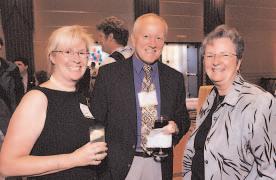
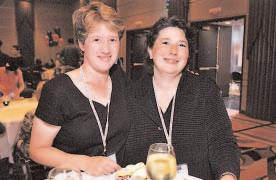

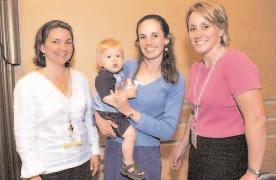
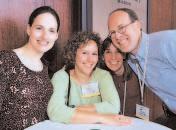
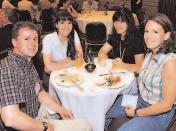
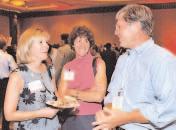
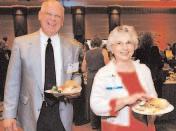
Nearly 400 Penn Veterinary Medicine alumni and their guests attended an alumni reception during the American Veterinary Medical Association Annual Convention in Philadelphia on July 25,2004.The reception was held at the Loews Philadelphia Hotel,located in the landmark PSFS Building.This year’s Convention was held in Philadelphia for the first time since 1973 and for the eighth time since the AVMA first met in Philadelphia in 1876.
During the reception,Dean Alan M.Kelly spoke on the state ofthe School,and everyone in attendance learned about the priorities of the School’s $100-million fundraising campaign, Building New Levels ofExcellence,by viewing a video made for the campaign.
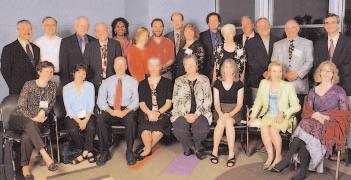
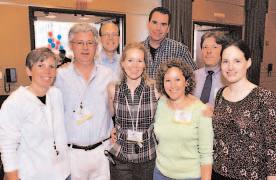
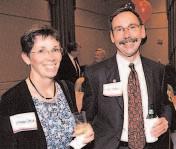
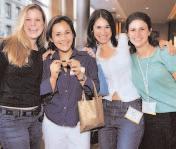
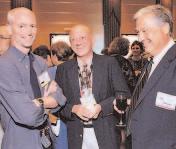
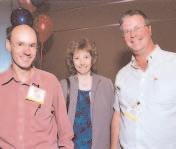
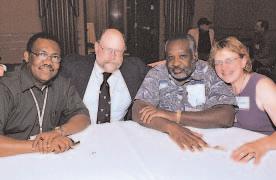
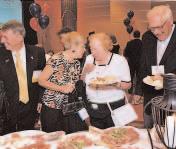
Standing:Norman N.Haber,Paul J.Kerns,Jeffrey G.Hunchar,Quinton J.Hanssens,Marcia E.Etheridge,Andrea Newman Orsher,Robert J.Orsher,Duncan C.Ferguson,Ella S.Boyd,Howard M.Eisenberg,Joan C.Hendricks,John F. Hampson,George G.Jeitles,Jr.,Michael S.Miller,and Mark W.Smith.
Seated:Margaret Landi,Amy R.Marder,James R.Rummel,Joan Regan,Sharon A.Dailey,Margaret B.Alonso, Louise E.Wechsler,and Elaine D.Salinger.
On August 1,2004,Penn Veterinary Medicine’s New Bolton Center held a champagne brunch at Saratoga Springs’historic Reading Room in honor ofPennsylvania’s favorite racehorse,Smarty Jones.


Approximately 50 people were there to raise funds for New Bolton Center,and to honor the great little horse who almost won a Triple Crown.Smarty’s owner,Mrs.Pat Chapman, sent her regrets and best wishes for a successful
event.Decision-making pressure about Smarty’s future prevented her and her husband, Roy,from attending.
Scott Palmer,V’76,ofthe New Jersey Equine Clinic,where Smarty Jones was treated by his fellow professional and Penn graduate, Patty Hogan,V’92,for a devastating head injury less than a year before he won the 2004 Kentucky Derby,were at the brunch and brought good wishes from Dr.Hogan and the Clinic staff.
The Section ofReproduction at New Bolton Center sponsored two third-year veterinary students who gave an outstanding performance in the Society for Theriogenology Student Case Presentations Competition that was held at the Society’s Annual Meeting in Lexington,Ky.in August.Both students initially submitted an abstract that was ranked for presentation at the national meeting.Each prepared and presented a 15minute PowerPoint presentation. Jennifer R. Feiner,V’05,sponsored by Patricia Sertich, V’83,won a cash prize and third place for her presentation entitled “Hydrops allantois in a mare.” Patrick J.Ford,V’05,sponsored by Regina Turner,V’89,won second place and a cash prize in the competition for his presentation entitled “Aortic-iliac thrombosis resulting in ejaculatory dysfunction in a stallion.”This was a great opportunity for these two equine-track students to speak to equine practitioners in Lexington.
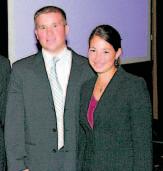
November 2004
6
7:00–10:00 p.m.
Alumni and Friends Reception
New England Aquarium
Boston,Mass.
For information,contact Amy Bogdanoffat (215) 898-4234 or at <bogdanof@vet.upenn.edu>.
17
2:00–4:00 p.m.
Veterinary Medical Alumni Society Executive Board Meeting
New Bolton Center
20
2004 Rush Shippen Huidekoper Society Dinner National Constitution Center,Philadelphia,Pa.
For information,contact Joshua E.Liss at (215) 8981481 or at <lissj@vet.upenn.edu>.
December 2004
5
6:00-8:00 p.m.
Alumni Reception
American Association ofEquine Practitioners
Annual Convention
Governor’s Square 12,Adam’s Mark Hotel,Denver,Colo. For information,contact Joshua E.Liss at (215) 8981481 or at <lissj@vet.upenn.edu>.
Matthew J.Ryan Veterinary Hospital of the University of Pennsylvania
24-Hour Emergency Service(215) 898-4685
Specialist Clinic Appointments(215) 898-4680
George D.Widener Hospital for Large Animals at New Bolton Center
24-Hour Emergency Service and Specialist Clinic Appointments(610) 444-5800
Penn Veterinary Medicine
General Information(215) 898-5438
Dean’s Office(215) 898-0600
Development and Alumni Relations(215) 898-1480
Student Admissions(215) 898-5434
Student and Curricular Affairs(215) 898-3525
January 2005
8–15
Pennsylvania Farm Show 2005 Farm Show Complex,Harrisburg,Pa.
Visit Penn Veterinary Medicine’s booth at the largest indoor agricultural event in America.
9
7:00–9:00 p.m.
Alumni Reception
The North American Veterinary Conference Marriott Orlando World Center Hotel,Orlando,Fla. For information,contact Joshua E.Liss at (215) 8981481 or at <lissj@vet.upenn.edu>.
26
2:00–4:00 p.m.
Veterinary Medical Alumni Society Executive Board Meeting Ryan Veterinary Hospital at Penn
29
Breeders Symposium Penn Campus,Philadelphia
Presented by the American Kennel Club and the AKC Canine Health Foundation and sponsored by Penn Veterinary Medicine.
February 2005
21
7:30–9:30 p.m.
Alumni Reception
Western Veterinary Conference Mandalay Bay Resort,Las Vegas,Nev.
For information,contact Joshua E.Liss at (215) 8981481 or at <lissj@vet.upenn.edu>.
March 2005
10–11
2005 Penn Annual Conference Adam’s Mark Hotel,Philadelphia,Pa. For information,visit <http://alumni.vet.upenn.edu/ pennannualconference.html>.
10
2:00–4:00 p.m.
Veterinary Medical Alumni Society Executive Board Meeting at 2005 Penn Annual Conference
11
2:00–4:00 p.m.
University ofPennsylvania School ofVeterinary Medicine
Editor
Helma Weeks
Photographers
Candace diCarlo
Addison Geary
Writers
Josephine Deubler,V.M.D.
Susan I.Finkelstein
Joan Capuzzi Giresi,V.M.D.
Greg Lester
Helma Weeks
Alumni Relations Liaison
Joshua E.Liss
Designer
Gary Hopkins
We’d like to hear your praise,criticisms,or comments. Please address your correspondence to:
Helma Weeks
University ofPennsylvania School ofVeterinary Medicine
3800 Spruce Street Philadelphia,PA 19104-6010
(215) 898-1475
hweeks@vet.upenn.edu
None ofthese articles is to be reproduced in any form without the permission ofthe editor of Bellwether ©Copyright 2004 by the Trustees ofthe University ofPennsylvania.
The University ofPennsylvania values diversity and seeks talented students,faculty and stafffrom diverse backgrounds.The University ofPennsylvania does not discriminate on the basis of race,sex,sexual orientation,gender identity,religion,color,national or ethnic origin,age,disability,or status as a Vietnam Era Veteran or disabled veteran in the administration ofeducational policies, programs or activities;admissions policies;scholarship and loan awards;athletic,or other University administered programs or employment.Questions or complaints regarding this policy should be directed to:Executive Director,Office ofAffirmative Action and Equal Opportunity Programs,Sansom Place East,3600 Chestnut Street,Suite 228,Philadelphia,PA 19104-6106 or by phone at (215) 898-6993 (Voice) or (215) 898-7803 (TDD).
3800 Spruce Street
Philadelphia, PA 19104-6008
Address Service Requested